Creating Web Push Campaigns
A step-by-step guide on creating Web Push campaigns in your dashboard
This guide only covers the creation of One-time, Triggered & Recurring CampaignsLooking to automate Transactional Web Push Notifications? Let's get you started!
Engaging users with Web Push Notifications is an effective way to grab their attention with offers, and drive platform engagement. Your dashboard comes with a highly intuitive 6-step campaign creation interface that makes it easy to execute highly personalized campaigns in minutes!
Must ReadAt WebEngage, we are obsessed with enabling consumer business, like yours, to create contextual experiences that facilitate retention-led growth. This is why user data (User Attributes), behavioral data (Events & Event Attributes) and Segments play an integral role in campaign creation. We recommend that you get yourself acquainted with the respective concepts before proceeding.
Here's a quick summary of the exciting possibilities offered by the campaign creation interface:
-
Personalize messages to each user's preferences and behavior, across the various stages of their lifecycle (skip to Step 3: Message)
-
Automate multivariate message testing for your campaign - we'll automatically identify a winner and send it to the entire audience (skip to Step 4: Conversion Tracking & Variation Distribution)
-
Leverage ready-to-use templates to engage users with rich Web Push Notifications (skip to Step 3: Message, Layout)
-
Test your campaign with internal team members before sending it to your users (skip to Step 5: Test Campaign)
-
Avoid disturbing users during DND hours, implemented in their timezone (skip to Step 2: When, DND)
-
Schedule campaigns for delayed delivery to users who are currently unavailable (skip to Step 2: When, Queueing)
Select Campaign Type
As shown below, the campaign creation interface can be accessed by clicking the Plus icon placed on the top left of the central hub of Web Push. In doing so, you will be prompted to select the type of campaign you'd like to create.
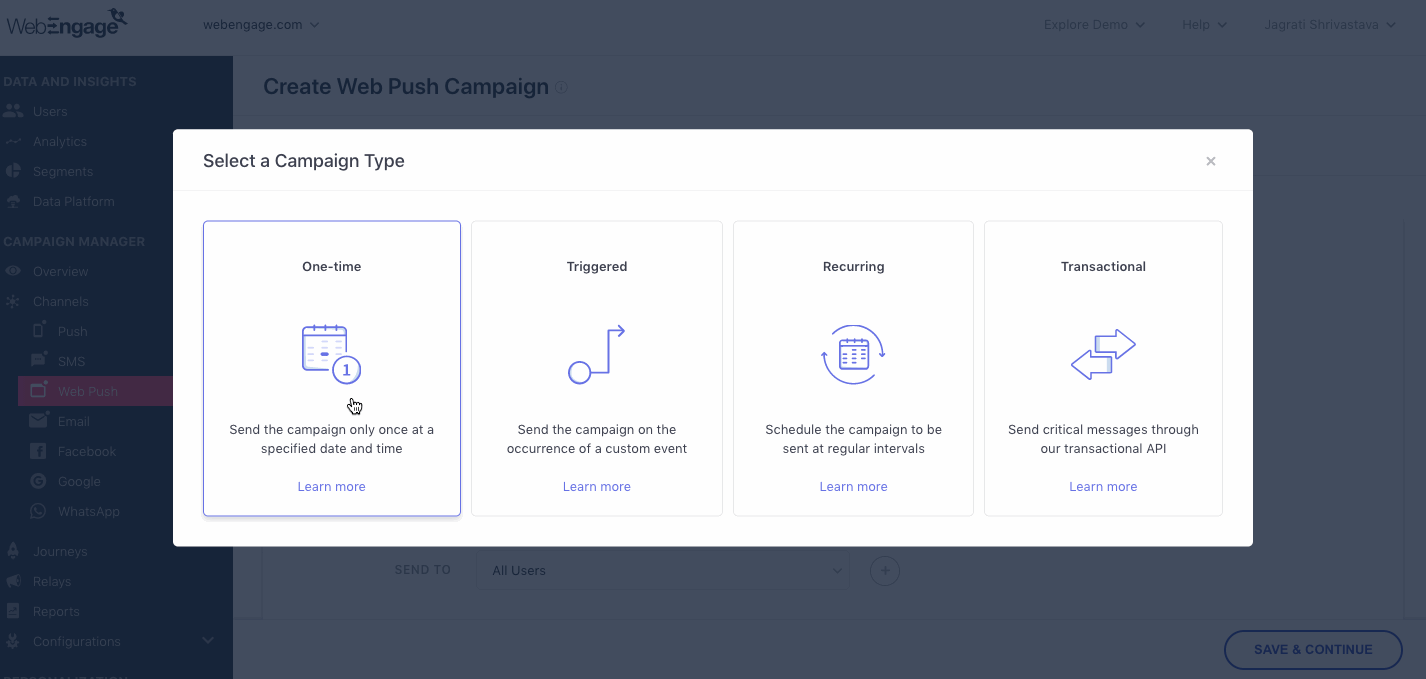
Click to enlarge
Let's quickly walk you through each campaign type:
These are stand-alone messages that are sent to your users only once and generally comprise of time-bound offers, festive deals, product updates and so on. Such campaigns end as soon as they're delivered to the target audience.
- When: Launch immediately or Schedule for later
- How Often: Once only
Skip to Step 2, When: Campaign Schedule > Setting up One-time Campaign
These are ongoing cycles of communication that are sent to only those users of your target audience, who perform a particular event on your app/website.
- When: Launch immediately or Schedule for later
- How Often: Whenever the specified Event is performed by a user or a few Minutes/ Hours/ Days after the event occurs
Skip to Step 2, When: Campaign Schedule > Setting up Triggered Campaign
These are ongoing cycles of communication that are scheduled to be sent periodically to its target audience. Such campaigns help you automate communication for several recurring events in your user's lifecycle like subscription renewals, policy renewals, bill payments, recurring investments and so on.
Or you could leverage these campaigns to engage all new users who have recently signed up, users who performed a certain action on your app but left without transacting or proceeding to the next stage and so on.
- When: Launch immediately or Schedule for later
- How Often: Daily, Weekly or Monthly
Skip to Step 2, When: Campaign Schedule > Setting up Recurring Campaign
These are highly contextual messages that your users expect to receive while interacting with your brand through your app, website or offline. This could be anything like acknowledging user interactions like, sign up (welcome newsletter), password reset, payment confirmation (invoice), order confirmation or conveying payment reminders, account statements and so on.
- When: Launch immediately
- How Often: Whenever a specific Event occurs in your backend
Continue here...Step-by-step Guide to Creating Transactional Web Push Campaigns
Now, let's walk you through all the steps of campaign creation.
Step 1: Define the Audience
1: Name your Campaign
The first step is to give your campaign a unique name that helps you identify its purpose.
2. Select Audience type
One of the key differentiators of a successful campaign is that they're tailored to the behavior and preferences of a specific group of users. Thus, by selecting an Audience Type, you can choose to target a particular segment of users or combine several segments to define your Email campaign's audience.
As shown below:
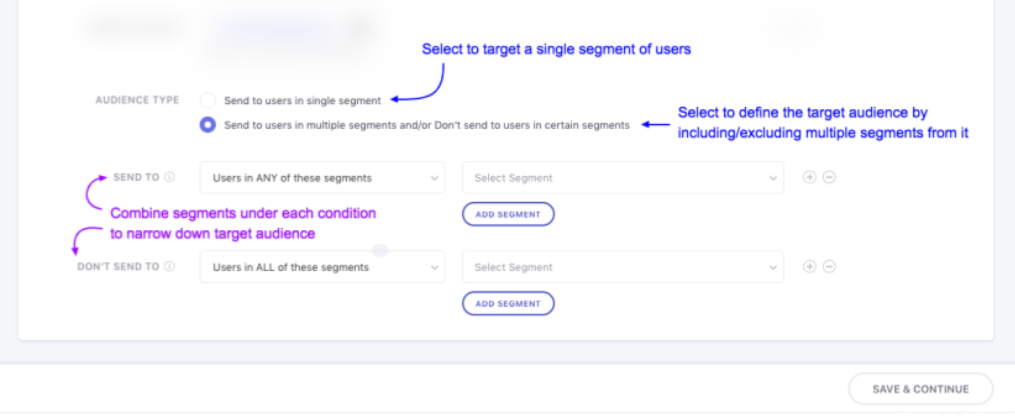
Click to enlarge
-
Select Send to users in single segment to target all users who are included within a particular segment (How to set it up)
-
Select Send to users in multiple segments and/or don't send to users in certain segments to narrow down the audience to a very specific user persona, defined by including and excluding several segments from the target audience (How to set up the conditions -Send To & Don't Send To)
3. Select Target Segment(s)
Here's how you can set up each Audience Type:
3A. Select a Segment (Send To)
(IfSend to users in single segment is selected as Audience Type)
As shown below, click the dropdown nested beside Send To, to specify the target segment.
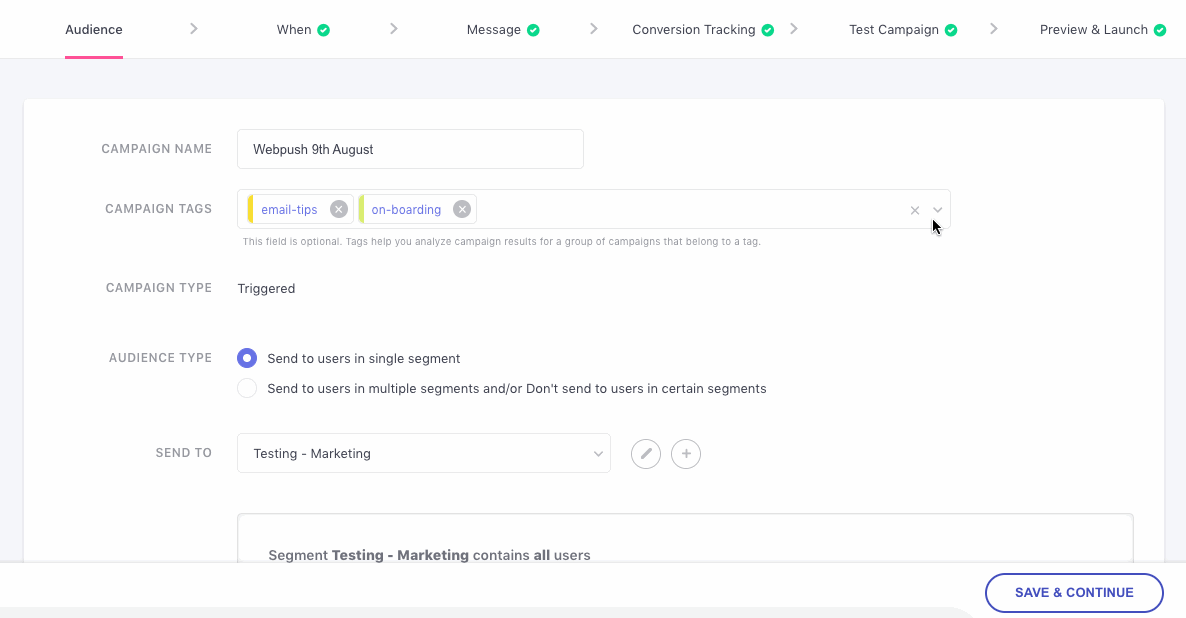
Click to enlarge
On selecting a segment, you will be able to preview a snapshot of Reachable Users and the Rules of Segmentation. Let's quickly walk you through Segment Preview:
-
Reachable Users: Indicates the number of users, from the selected segment, that can be engaged through Web Push as a channel, at present.
-
Rules of Segmentation: You can choose to segment your entire user base by 3 broad parameters - User (attributes), Behavior and Technology. Thus, Segment Preview presents a snapshot of all parameters, based on which the users have been grouped together.
Skip to:
3B. Combine Segments (Send To)
(IfSend to users in multiple segments and/or don't send to users in certain segments is selected as Audience Type)
Using multiple segments to define the target audience is an excellent way to target users that have similar preferences, belong to the same location or have performed certain actions on your website - without creating a new segment.
Here's how you can go about it:

Click to enlarge
Step 1: Select a Condition
-
SelectUsers in ANY of these segments to send the campaign to all the users included within each segment.
-
*Select Users in ALL of these segments to send the campaign only those users who are shared by all the segments.
Step 2: Select a Segment
Step 3: Click Add Segment to specify another one.
Skip to:
3C. Exclude Segments (Send To)
(IfSend to users in multiple segments and/or don't send to users in certain segments is selected as Audience Type)
You can choose to exclude a segment or multiple segments from the target audience by configuring the field, Don't Send To. This is a great way to selectively engage users that match a specific persona. Here's how you can go about it:

Click to enlarge
Step 1: Select a Condition
-
SelectUsers in ANY of these segments to prevent users in each segment from receiving the campaign.
-
SelectUsers in ALL of these segments to prevent only those users from receiving the campaign that are common between all the segments.
Step 2: Select a Segment
Step 3: Click Add Segment to select another one.
When Segment Isn't Specified Under the field, 'Send To'By default, a campaign is set to be delivered to All Users. Thus, if no segment is selected under Send To AND segments are specified under Don't Send To, then the campaign will be send to all the users who arereachable on Web Push AND are not included within the specified segments.
Edit Segment
Click the Edit icon, placed next to the dropdown, Send To, to edit the selected Segment. In doing so, you will be prompted by a pop-up, pre-populated with the existing rules of segmentation, as shown below.

Click to enlarge
Simply make your edits and click Save to proceed. In doing so, you will able to preview the number of reachable users as per your edits.
Create a New Segment
You can choose to create a new Segment_of users from the campaign creation interface by clicking on the _Create Segment button. In doing so, you will be prompted by a pop-up, allowing you to build a new segment, as shown below.
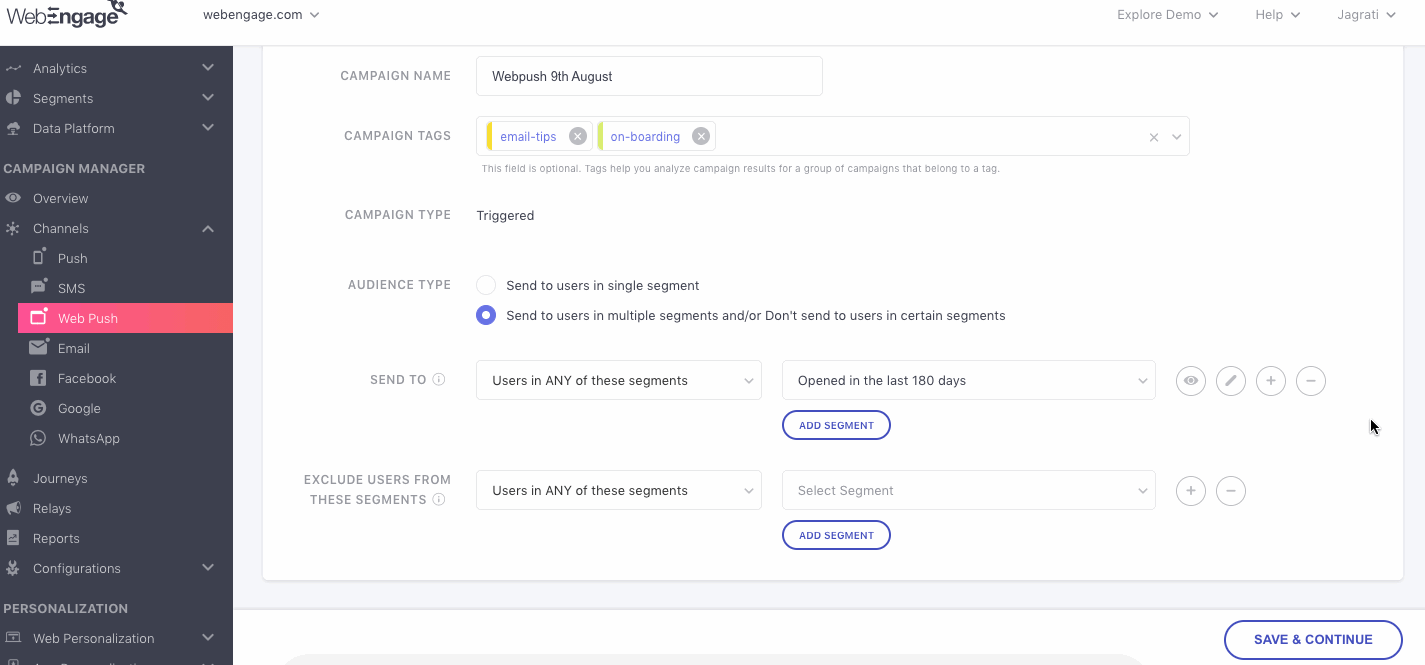
Click to enlarge
Once created, you will be able to access the Segment through the List of Segments in your dashboard.
Creating a New, Single-use Segment
You can also choose to create disposable segments or segment users specifically for the campaign and avoid adding it to the List of Segments in your dashboard.
This can be achieved by leaving the field, Name blank while creating the segment. In doing so, it will become an Ad hoc segment in your dashboard which will be available only for sending the campaign you're currently creating.
Related Read: Rules of SegmentationPlease refer to Creating Segments for step-by-step guidance on how you can segment your users by their attributes, behavior (events), and technological preferences.
Apply Universal Control Group
Conditional OptionThis is a conditional option which will be shown only if the you have created Universal control group in your account. Click here to know how to create Universal control group.
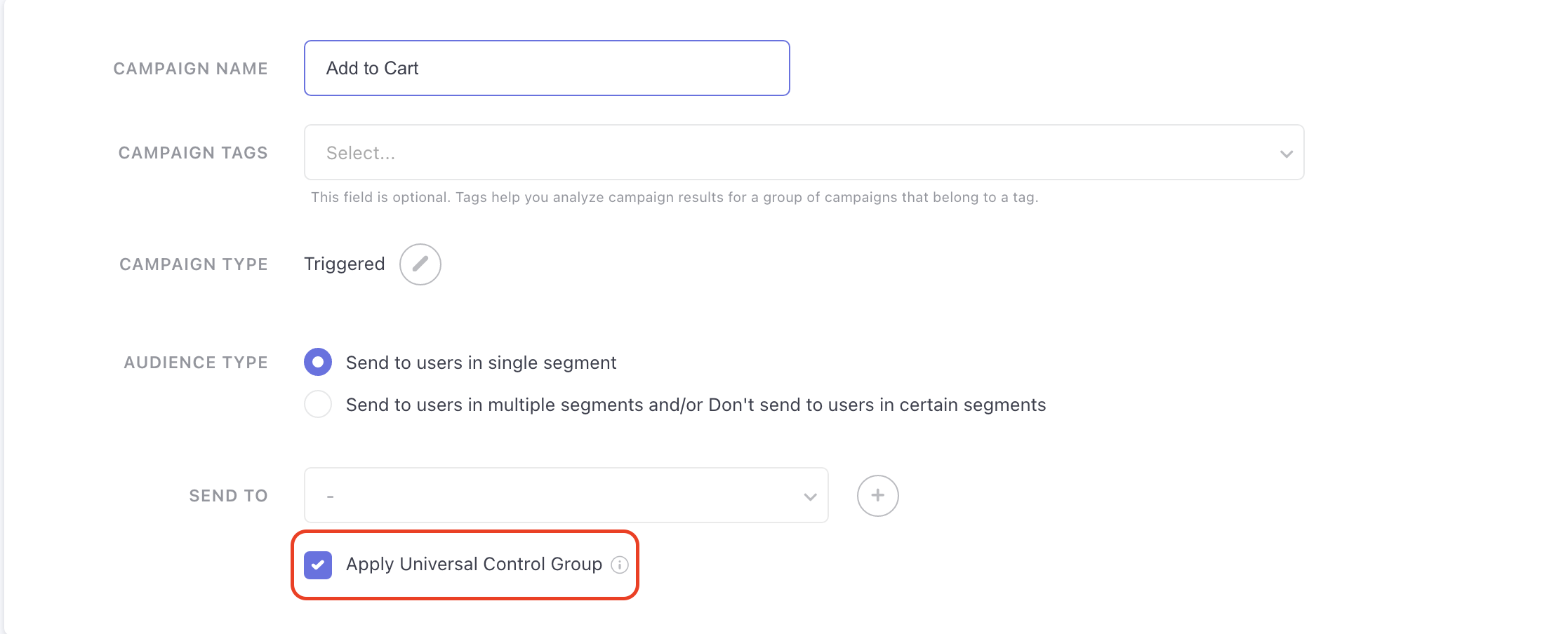
click to enlarge
- When the box is checked, the campaign will not be sent to users who are part of the Universal Control Group in the segment that is selected.
- When the box is unchecked, the campaign will be sent to all users that are part of the segment inclusive of the Universal Control Group users.
Step 2: Specify When to Send
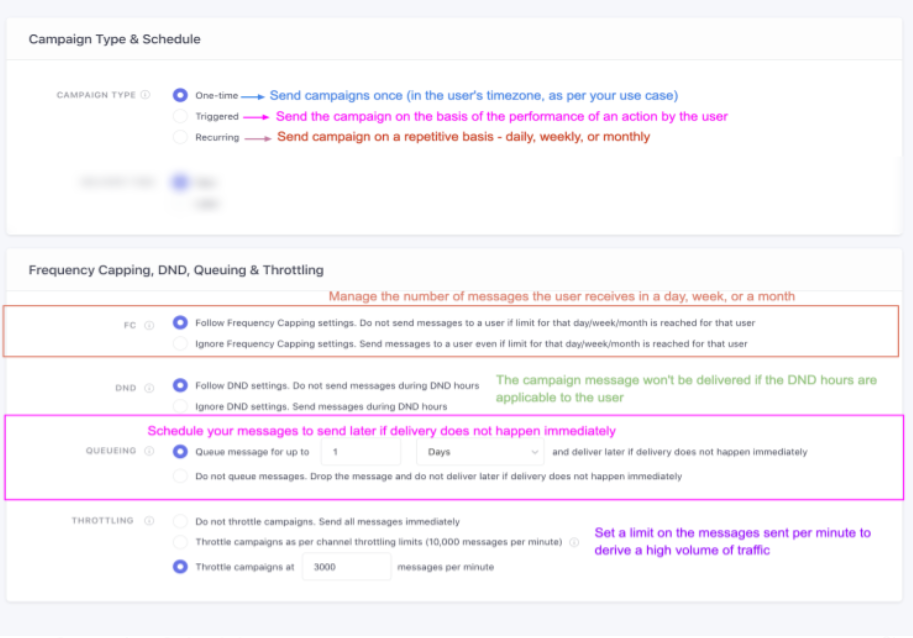
Click to enlarge
As highlighted above, the second step of campaign creation allows you to specify when and how often you'd like the target audience to receive the Web Push Notification and manage the role your campaign plays in your overall engagement strategy. Hence, When has been divided into two sections:
- Campaign Schedule
- Frequency Capping & DND
Let's get you acquainted with the workings of each:
Campaign Schedule
Here you can specify when and how often the target audience should receive the campaign. This can be determined by configuring the Campaign Type selected when you initiated creation. Here's how you can go about it:
Navigate to:
Setting up One-time Campaign
Step 1: As shown below, select One-time as the Campaign Type
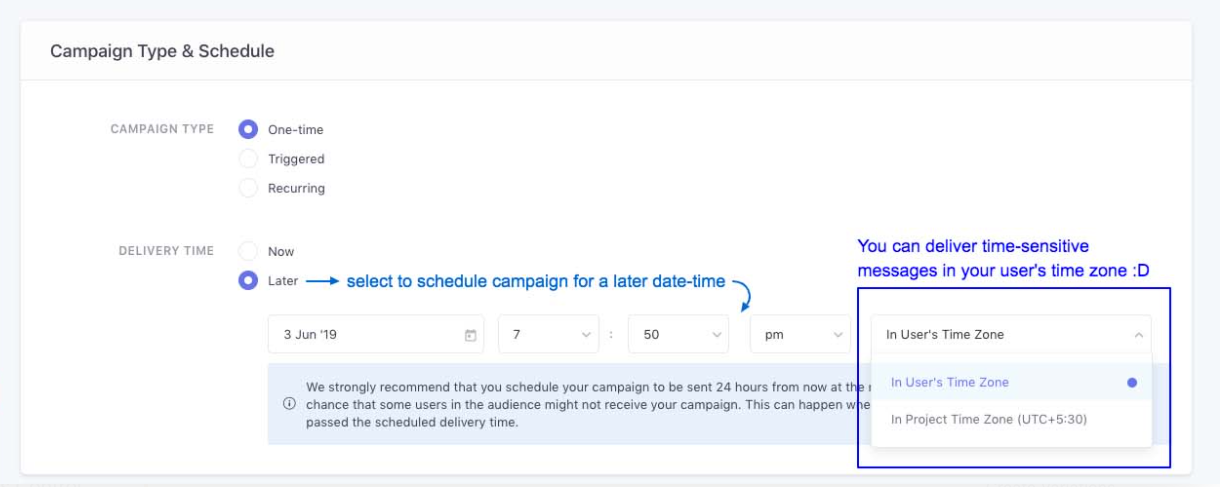
Click to enlarge
Step 2: Specify the Delivery Time
As shown above:
- SelectNow to send the campaign immediately
- SelectLater to schedule the campaign:
You can choose from the 2 options i.e. Send Intelligently or to send at a specific time.- Send Intelligently: optimizes campaign send-time for each user, our system intelligently decides the best time to send a campaign based on your user’s interactions with past campaigns of each channel. Click here to know more.
- Send at Specific Time: You can specify the time at which you would like to send your campaign to your users, either from the users time zone or the campaign's project time zone.
You can choose to schedule a one-time Push campaign for delivery in your user's timezone! (How it works)
Skip to Frequency Capping & DND to complete Step 2: When, of the campaign creation process.
Setting up Triggered Campaign
Step 1: As shown below, select Triggered as the Campaign Type
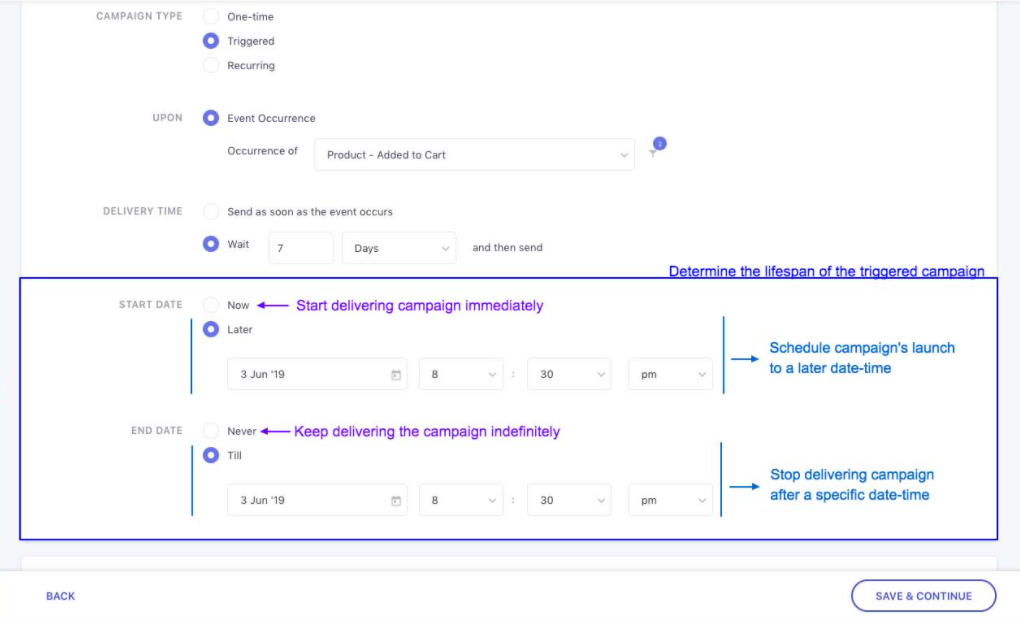
Click to enlarge
Step 2: As shown above, select theEvent upon the occurrence of which the campaign will be triggered or sent to the user
- For example, in the above visual we have selected the custom event Product - Added to Cart as the trigger event
The following options can be selected here:
Custom (all thecustom events being tracked for your account)
System (all thecampaign events pre-defined by us for tracking user-channel interactions like app installed, push delivered, push opened and so on.)
Step 3 (Optional): Add Attribute Filters to the Event by clicking on the filter icon.
The following options can be selected here:
Custom (all the custom attributes attached to the custom event selected as the trigger event)
Time (Event Time)
Location (City, Country)
Technology (Device Manufacturer, Device Model, Carrier, App Version, App ID, SDK Version)
Engagement (Campaign ID, Journey ID - can be found under thecampaign's overview & journey's overview)
- These attributes are applicable only to campaign events like Email Rejected, Push, Dismissed and so on.
Others (Session Count, Language)
-
Further, you can choose to club multiple event attributes by the AND/OR logic to define the scope of occurrence of the event.
-
Doing so implies that if users included within the target segment don't perform the specified Event, in the context of the added attribute filter(s), then they will not receive the campaign.
How It Works: Clubbing Event Attributes by AND/OR LogicAND: Implies that users will have to perform theEvent in the context of all the event attributes to receive the campaign. (Helps you narrow down the target audience)
OR: Implies that users will receive the campaign if they perform theEvent in the context of eitherevent attribute.* (Helps you widen the target audience)
Step 4: Specify the Delivery Time of the triggered campaign
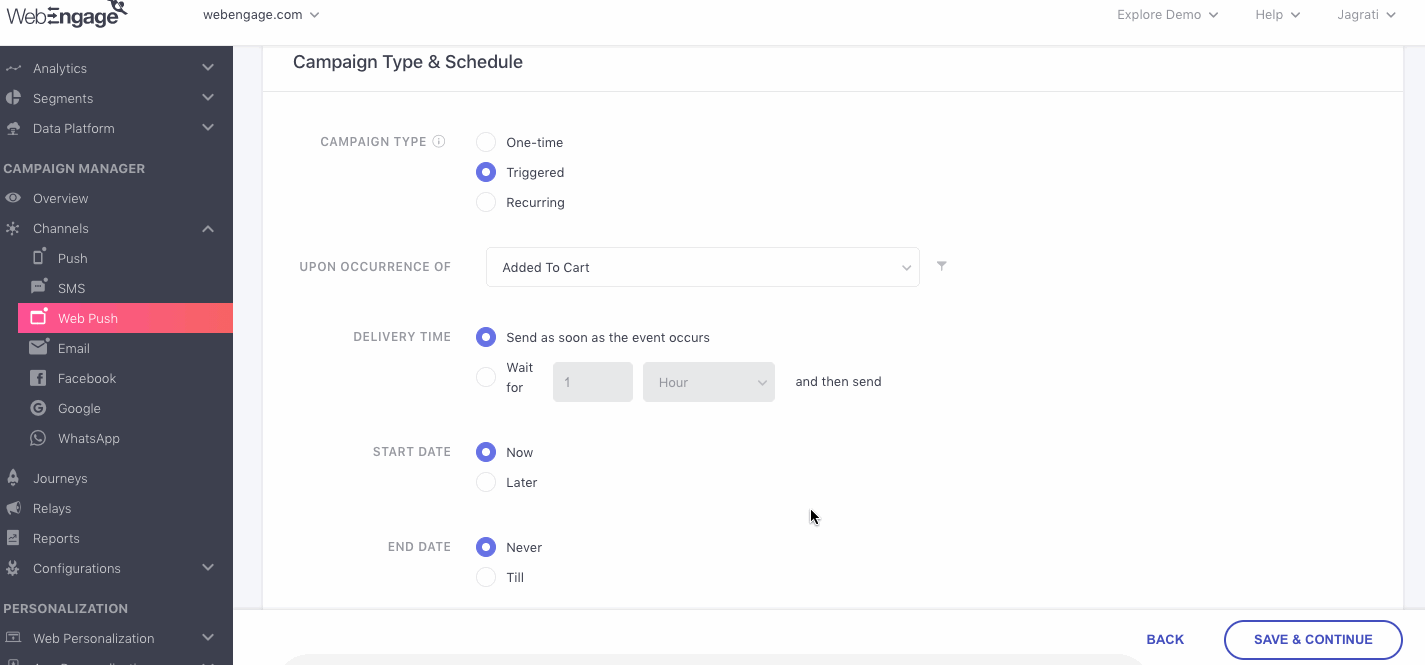
Click to enlarge
As shown in the above:
- SelectSend as soon as the event occurs to delivery the campaign immediately
- SelectWait for (duration) and then send to deliver the campaign after sometime
- You can set up a wait time in Minutes, Hours or Weeks, after which, the campaign will be sent to the respective users
Step 5: Specify the Start Date or the date-time on which the triggered campaign should start getting delivered to the target audience
As highlighted in the visual below:
- SelectNow to send the campaign immediately
- SelectLater to schedule the campaign
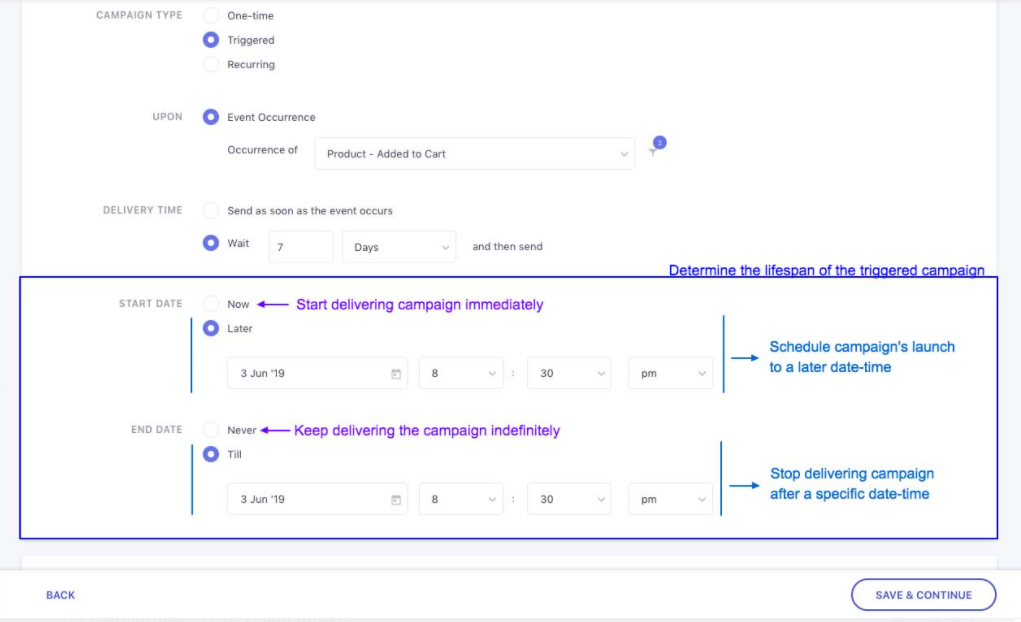
Click to enlarge
Step 6: Specify the End Date or the date-time on which the triggered campaign should cease getting delivered to the target audience
As highlighted in the visual above:
- SelectNever to run the campaign indefinitely (you can always choose to Pause a campaign manually through its Campaign Overview)
- SelectLater to stop the campaign at a specific date-time in the near future
Skip to the second section, Frequency Capping & DND to complete Step 2: When, of the campaign creation process.
Setting up Recurring Campaign
Step 1: As shown below, select Recurring as the Campaign Type

Click to enlarge
Step 2: Specify the Delivery Schedule or the frequency and date-time of campaign delivery.
As shown in the visual above, the frequency of a recurring campaign can be set as:
- Daily, at a specific Time
- Weekly, at a specific Day and Time
- Monthly, on a specific Day of the Month and Time
Step 3: Specify the Start Date or the date-time on which the recurring campaign should start getting delivered to the target audience.
As highlighted in the visual below:
- SelectNow to send the campaign immediately
- SelectLater to schedule the campaign
View Realised Schedule shows you the entire schedule for your campaign as set by you.
Step 4: Specify the End Date or the date-time on which the campaign should cease getting delivered to the target audience
As highlighted in the visual above:
- SelectNever to run the campaign indefinitely (you can always choose to Pause a campaign manually through its Campaign Overview)
- SelectLater to stop the campaign at a specific date-time in the near future
Frequency Capping, DND, Queuing & Throttling
Here you can leverage the features of Frequency Capping (FC), DND Hours, Queueing and Throttling to determine how a user perceives your Push campaign in the context of your entire engagement experience.
Context: Campaigns don't exist in isolation. Most marketing campaigns are designed for a specific audience, motivating them to perform a particular action. And more often than not, users receive multiple campaigns through various channels, nudging them towards a similar goal.
Thus, these features allow you to manage the frequency and timing of campaign delivery for each user. Let's get you acquainted with the workings of each:
FC
Using Frequency Capping (FC), you can control the number of campaigns a user receives within a Day, Week, Month and maintain a consistent gap between consecutive messages (sent through multiple channels or the same channel).
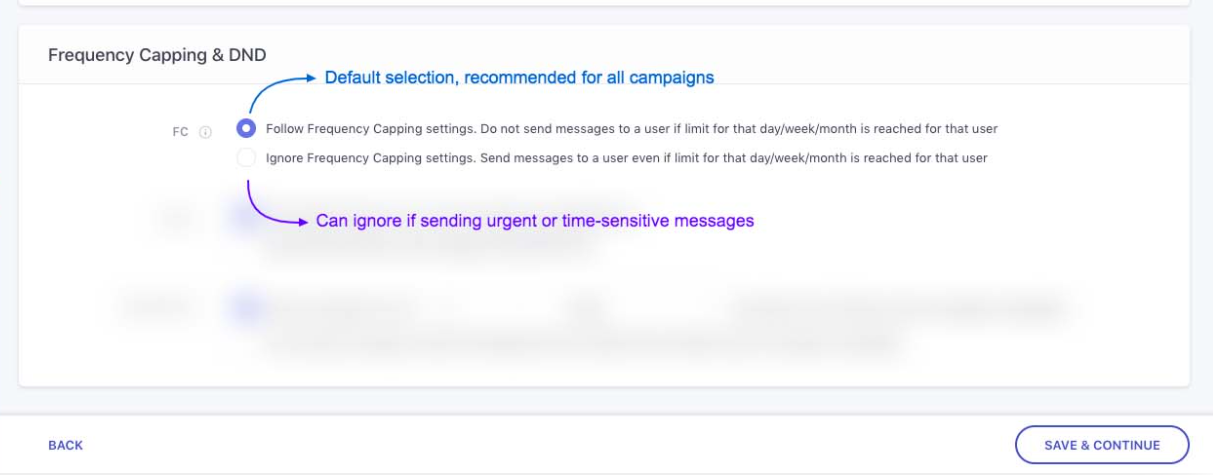
Click to enlarge
As highlighted above:
-
SelectFollow... to send the campaign as per your account's frequency capping and time gap settings
- This means that if the upper limit on the number of messages a user can receive within a day, week or month is exhausted, then this campaign will get queued for delayed delivery (detailed read on how this works)
-
SelectIgnore... to ensure campaign delivery even if the frequency cap for the day/week/month has been met for a user (impact of disabling FC for a campaign)
Set Frequency Capping Limits
If you have not set up Frequency Capping yet, then you can choose to configure it by clicking the Set Frequency Capping Limits button. As shown above, in doing so you will be directed to your account's settings, in a new tab. (How to configure FC & Time Gap)
- Once set, you will be able to send all your campaigns with FC enabled, including the existing one.
- Pro Tip: Toggle back to the campaign creation tab and refresh to enable FC.
DND
Using the DND Settings of your account, you can prevent users from receiving campaigns during specific periods such as when they may be asleep, and so on. The best part - DND hours are determined individually for each user. This means that the duration specified by you will be applied to all your users only in the context of their time zone!
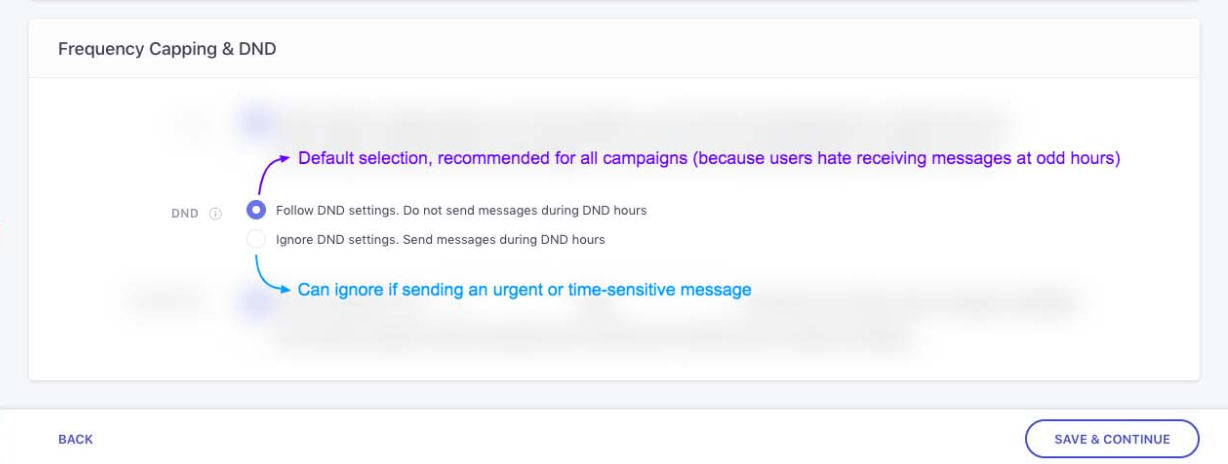
Click to enlarge
As highlighted above:
- SelectFollow... to ensure that users aren't disturbed by the Push Notifications at the hours specified by you (as per their timezone)
- SelectIgnore... to ensure campaign delivery even if _DND hours are applicable to a few users (Disabling DND for a campaign)_
Set DND Hours
If you haven't set up DND Hours yet, then you can choose to configure it by clicking the Set DND Hours button. As shown above, in doing so you will be directed to your account's settings, in a new tab. (How to configure DND Hours)
- Once set, you will be able to send all your campaigns with DND hours enabled, including the existing one.
- Pro Tip: Toggle back to the campaign creation tab and refresh to enable DND.
Queueing
If you choose to send a campaign with FC or DND enabled, then Queueing is automatically enabled. It's a feature that allows delayed delivery of the message to a user, in cases where immediate delivery is not possible due to your FC or DND settings.
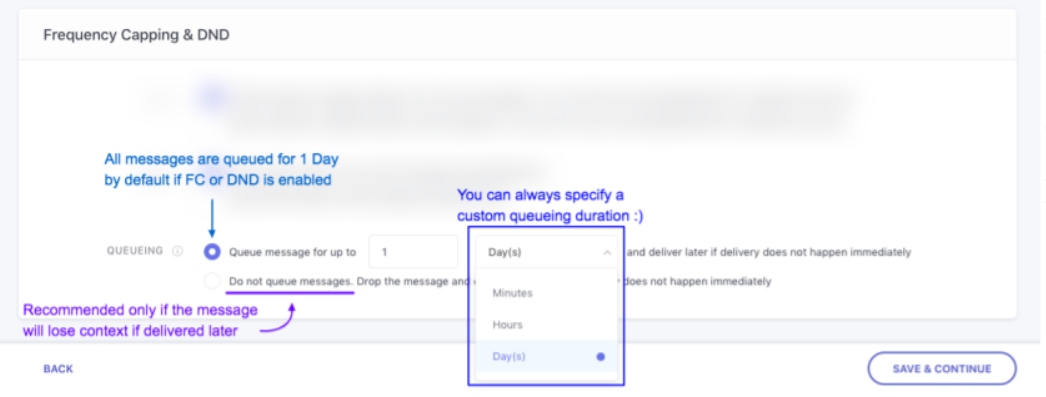
Click to enlarge
As highlighted above:
- SelectQueue message for up to..., to enable the feature and specify a custom queueing duration for the campaign in Minutes, Hours or Days.
- Doing so will ensure that we hold on to the campaign for the specified duration and send it only when a combination of your FC and DND settings allow us to. (How delivery time is determined for queued messages)
- SelectDo not Queue messages... to drop the message if we're unable to deliver it to a user due to FC/DND settings (Disabling Queueing for a campaign)
Throttling

Click to enlarge
As highlighted above:
-
SelectDo not throttle campaign... to send all messages instantly to the entire target audience.
-
SelectThrottle campaigns as per channel throttling limits to control the number of messages delivered per minute.
-
SelectThrottle campaigns at... to specify a custom message throttling duration for this campaign.
- Please note, this limit cannot be higher than the channel-level throttling limit specified under Settings > Throttling.
Step 3: Create the Message

Click to enlarge
As highlighted above, the message creation interface comes loaded with intuitive features like Variations, Layouts, Personalized Button Links and Message Preview - enabling you to create high impact Web Push Notifications in minutes.
Let's get you acquainted with each feature:
Select a Layout
You can choose from the following ready-to-use templates to create a Variation.
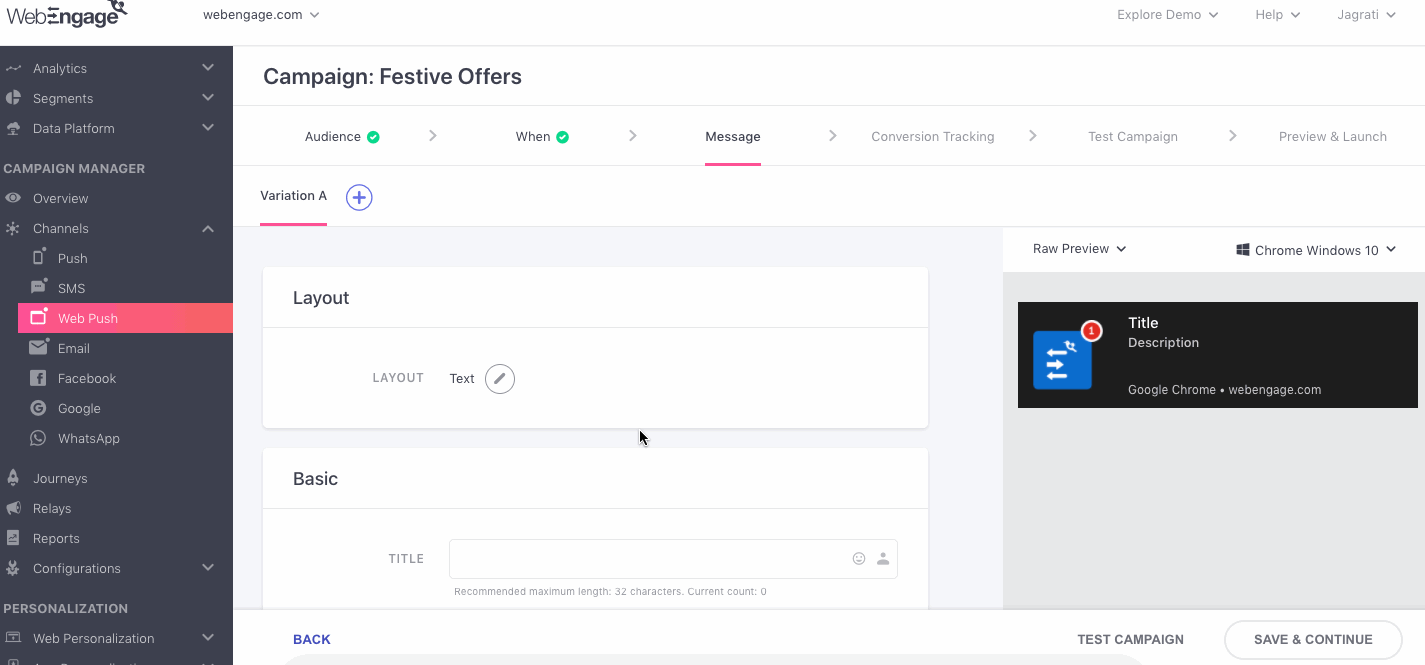
Click to enlarge
Text: A text-only template, allows you to send quick updates and offers, personalized to each user's preferences and behavioral history. (Creating dynamic text notifications)
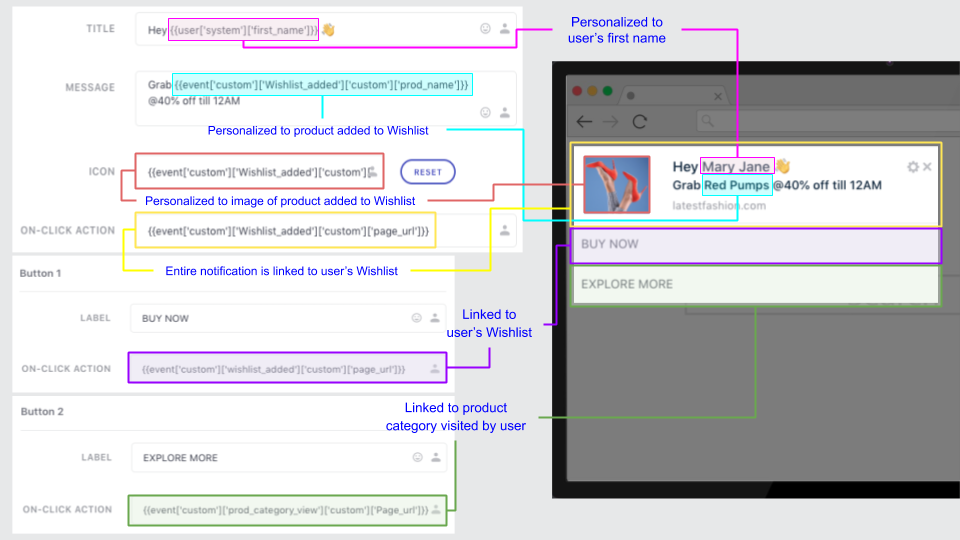
Personalising Text Web Push Notifications
Banner: A single-fold media template that allows you create visually personalized notifications. (Creating personalized banner notifications)

Personalising Banner Web Push Notifications
You can always choose to change the template of a Variation by clicking the Edit icon, allowing you to start building the message from scratch.
Related ReadImage and text guidelines for creating Web Push Notifications
Basic (Message)
As you may be aware, the way your users experience a Web Push Notification depends heavily on the Browser and OS they're using. For example, Chrome & Firefox browsers in Mac devices don't support banner images. The color scheme of your notification may appear drastically different in Windows 10 devices compared to lower versions. While the button placement will differ for mobile and desktop devices.
This is why we have made it extremely easy for you to preview the layout for all the popular Browser-OS combinations and have the limitations of each element alongside the steps listed below.
Step 1: Create a Dynamic Text Template
(Number of characters shown in the notification may differ as per the OS & Browser)
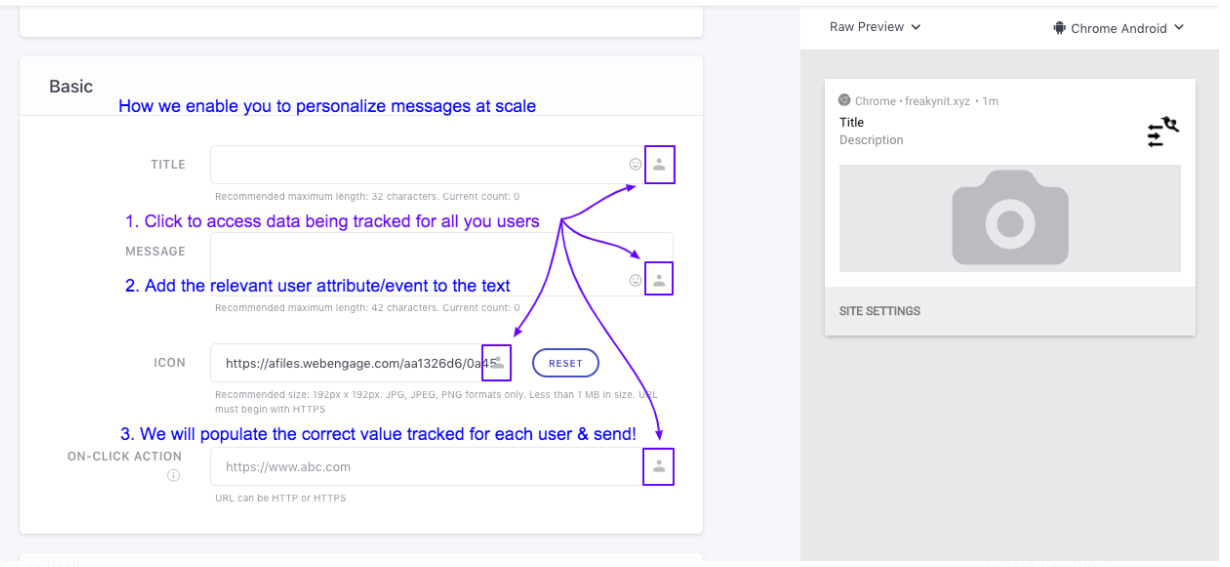
Click to enlarge
Using the Personalization icon nested under each field, you can easily create dynamically personalized content. Simply select a value from a list of all the Custom User attributes and Custom Events being tracked for your account and place them appropriately within the message. We'll add the exact value tracked for each user, helping you deliver one-on-one messages at scale :)
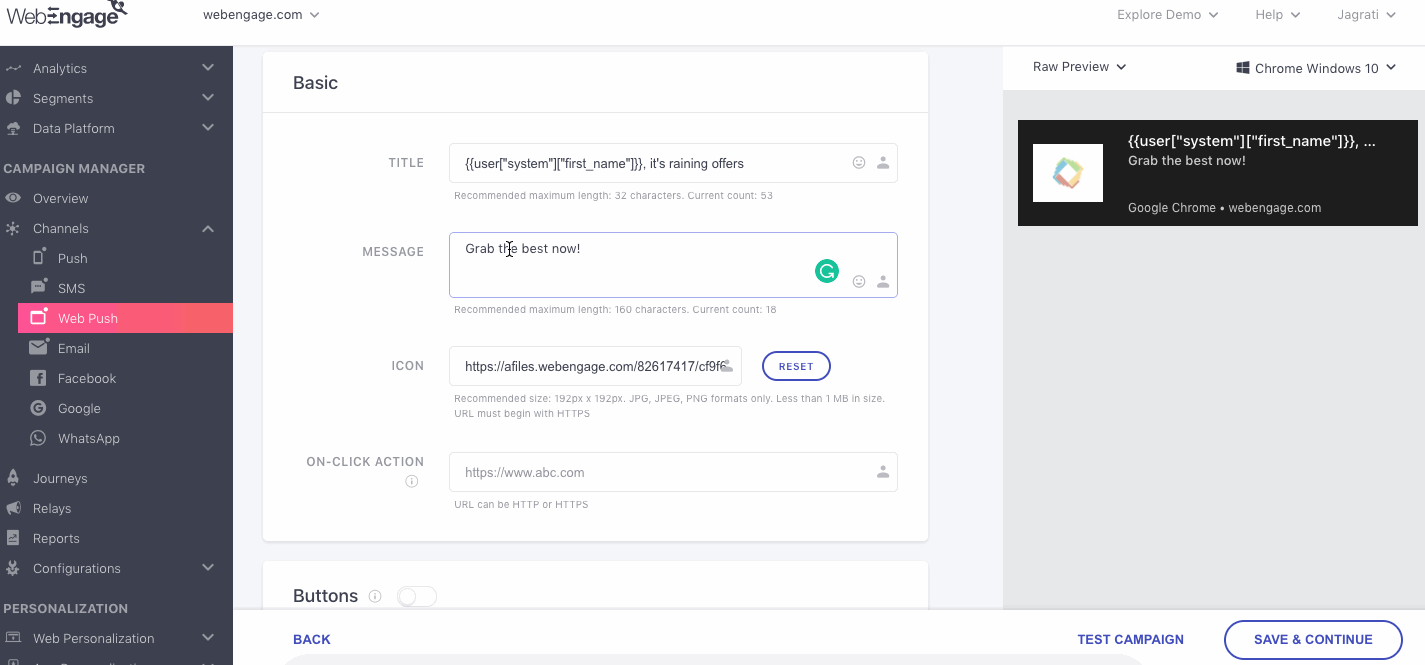
Click to enlarge
Step 2: Add Custom Icon
Support by all Browser-OS combinations, adding an icon to your notification is one of the best ways to ensure that users instantly recognize your brand, helping you drive better engagement & conversion rates. This is why we recommend that you personalize the icon to each user for maximum impact!

Click to enlarge
As shown above, a generic icon can be added in two ways:
1. Insert Image Link: The image must be hosted on a crawlable/publicly accessible domain to ensure that it renders for all users receiving the message.
2. Upload Image: Click the Upload button and select a file from your desktop. In doing so, the image will get hosted on WebEngage's domain: https://afiles.webengage.com.
You can always click the Reset button to link/upload a new icon.
Personalizing Icon to User's Preferences & Behavioral HistoryYou can easily personalize the icon to each user in any of the following ways:
Method 1: Pass image_url as a custom event attribute, attached to a custom event gleaned for your website (Step-by-step guide on how to execute this)
Method 2: Build the image URL by specifying a parent link and adding a custom event attribute/custom user attribute as the path. Then manually add the image format like, .png, .jpeg, .jpg, .gif, at the end of the link structure (Step-by-step guide on how to execute this)
Step 3: Add On-click Action Link
Add a link to the web page you'd like to direct users to when they click anywhere on the notification, barring the buttons. We recommend that you personalize the link to each user for maximum impact!
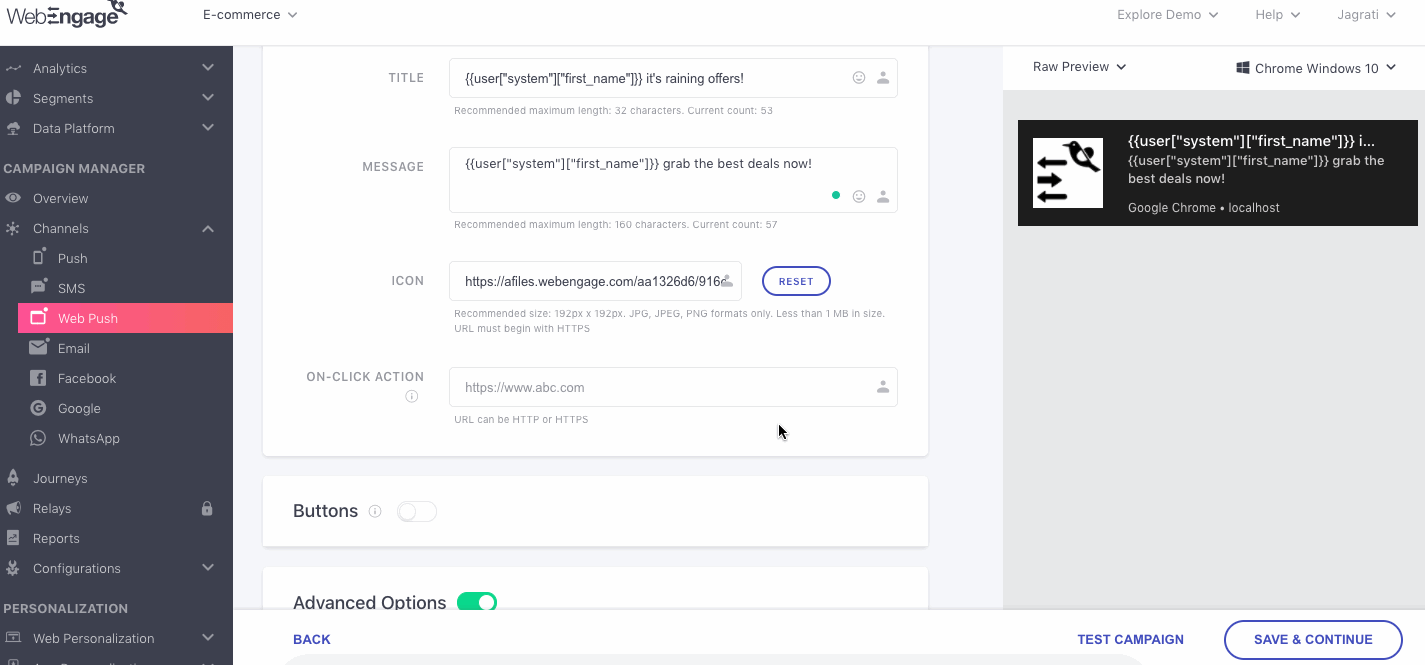
Click to enlarge
For example, in the visual above, we have personalized the link to the page viewed by a user by adding the Custom Event, Product Page Viewed and its Custom Attribute, page_url to the field.
Personalizing On-click Action Link to User's Preferences & ActionsYou can easily personalize links to your users in any of the following ways:
Method 1: Pass screen link or pagel_url as a custom event attribute, attached to a custom event gleaned for your app and website, respectively.(Step-by-step guide on how to execute this)_
Method 2: Build the URL or deep link by specifying a parent link and adding a custom event attribute/custom user attribute as the path parameter (Step-by-step guide on how to execute this)
Configure Banner Image
(Applicable only to Chrome v56 & above on Windows, Android and Microsoft Edge v17 & above)
If you have selected Banner as the layout for a Variation, then using this section, you will be able to add the image and even personalize it to each user's preferences/behavior.
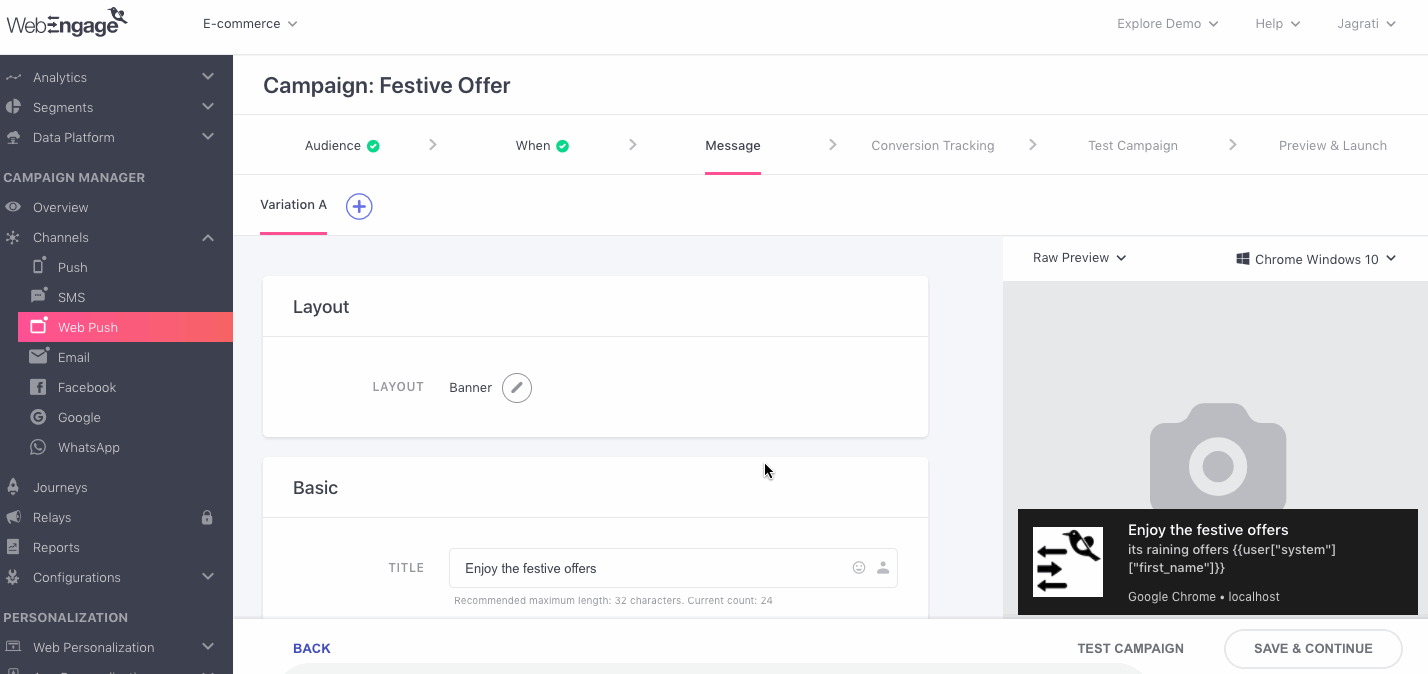
Click to enlarge
As shown above, a generic banner image can be added in two ways:
1. Insert Image Link: The image must be hosted on a crawlable/publicly accessible domain to ensure that it renders for all users receiving the message.
2. Upload Image: Click the Upload button placed next to the field, image and select a file from your desktop. In doing so, the image will get hosted on WebEngage's domain: https://afiles.webengage.com.
You can always click the Reset button to link/upload a new image.
Personalizing Banner Image to Each User's InterestsYou can easily personalize images to the preferences & behavioral history of your users in any of the following ways:
Method 1: Pass image_url as a custom event attribute, attached to a custom event and add it as the image link (Step-by-step guide on how to execute this)
Method 2: Build the image URL by specifying a parent link and adding a custom event attribute/custom user attribute as the path parameter. Then manually add the image format like, .png, .jpeg, .jpg, .gif, at the end of the link structure (Step-by-step guide on how to execute this)
Configure Buttons
(Applicable only to Chrome v48 & above on Windows, Android and Microsoft Edge v17 & above)
As shown below, click the toggle button to enable and add up to 2 buttons to your notification.

Click to enlarge
Here's how you can configure each button:
Step 1: Add Label (CTA)
Label refers to the button's text or call-to-action. You can specify a generic label for each button or personalize it to an action performed by your users, creating a highly contextual experience!
Fact CheckThe Label and On-click Action link must be in sync to deliver a consolidated Web Push experience
Step 2: Insert Link (On-click Action)
As highlighted above, add a link to the web page you'd like to direct users to when they click on the button. We recommend that you personalize each link to your users for maximum impact!
Personalizing On-click Action to a User's Preferences or Behavioral HistoryYou can easily personalize the button link to your users in any of the following ways:
Method 1: Pass screen_url as a custom event attribute, attached to a custom event gleaned for your app (Step-by-step guide on how to execute this)
Method 2: Build the image link by specifying a parent link and adding a custom event attribute/custom user attribute as the path parameter (Step-by-step guide on how to execute this)
Advanced Options
1. Disable Auto-Hide Notification
(Applicable only to Chrome v47 & above on Windows)
Most browsers auto-hide the Web Push Notification after a few seconds of inactivity. While this is a great way to create a non-intrusive browsing experience, you can always choose to disable it. Doing so will keep the notification visible until a user clicks on it or dismisses it.
- Both actions are tracked as the campaign events, Notification Clicked and Notification Dismissed, respectively.

Click to enlarge
As shown above, click the toggle button to enable Advanced Options and click the checkbox to disable auto-hide.
2. Add Custom Badge
(Applicable only to Android v6+ users on Chrome v56+)
If you're targeting a large number of Android users, then you can easily choose to replace the Chrome badge with a custom badge that resonates with your brand. This is a great way to subtly enforce brand recall for your users while engaging them within tailored communication.
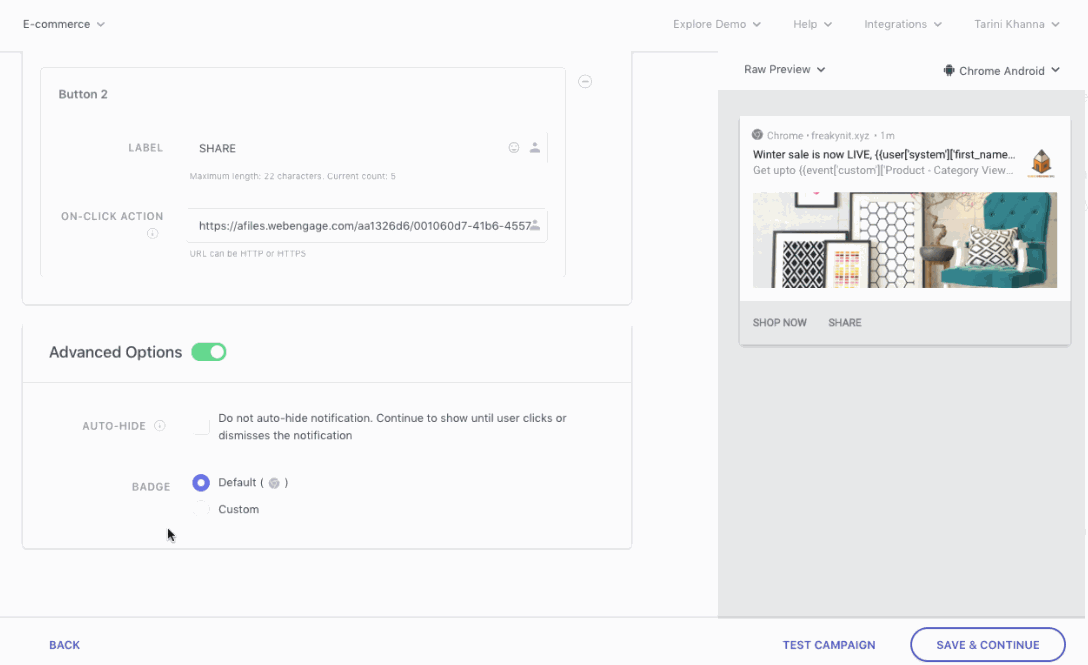
Click to enlarge
As shown above:
Step 1: Select Custom against Badge to upload your own.
Step 2: Add a link to the badge or upload the image file to the dashboard under the field, Badge. Please adhere to the following guidelines while doing so:
- The badge must be monochrome as RGB colors are not supported by the OS-browser.
- We recommend a width:height ratio of 1:1 with the ideal image size being 72px by 72px.
- Please upload the image in .png, .gif, .webp, .ico, .cur, .bmp formats only, in a file size not exceeding 1MB.
- If you're adding a link, then please ensure that the image is hosted on an https domain.
You can visualize the Badge's appearance through the Preview section by selecting Chrome Android.
UTM Parameters
- Start by enabling UTM at the global level through the Configurations section on the dashboard. This ensures that campaign-level UTM tagging is enabled by default. Click here to know how.
- Modify or Edit UTM at Campaign Level: While global UTM is setup, you can modify parameters for specific campaigns as well as per you needs.
- Disabling Global UTM: While disabling the UTM setup at global level you can choose whether to keep UTM for already running campaigns or remove it from all campaigns.
Note: Campaigns which are already sent with UTM parameters cannot be removed.
Preview Notification
Depending on the OS and browser through which your users have opted-in, certain elements of the message may appear differently, or may not appear at all.
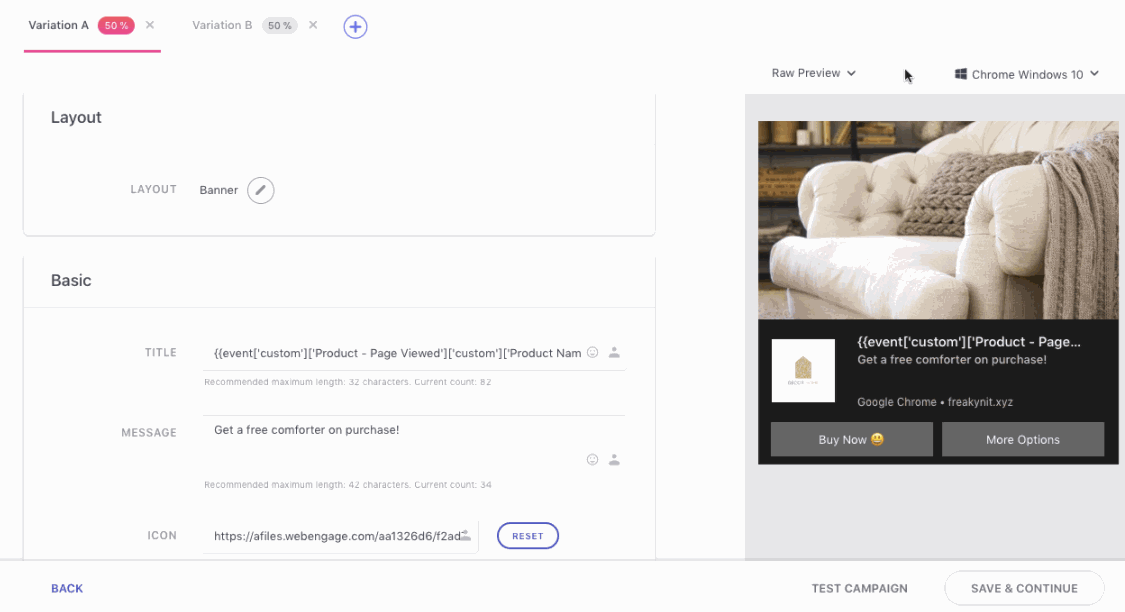
Click to enlarge
As shown above, you can preview the notification's appearance through the left half of the campaign creation interface. You can toggle between multiple Browser-OS combinations to view the message as it is (raw preview) or as per a specific user's data (user preview).
Notification's appearance can be visualized for the following browser & OS combinations:
Chrome Windows 10
Chrome Windows (OS v9 & below)
Chrome Mac
Chrome Android
Firefox Windows
Firefox Mac
Raw Preview
As the name suggests, it renders the Web Push Notification with the raw text and attributes, as added by you to the Title & Message.
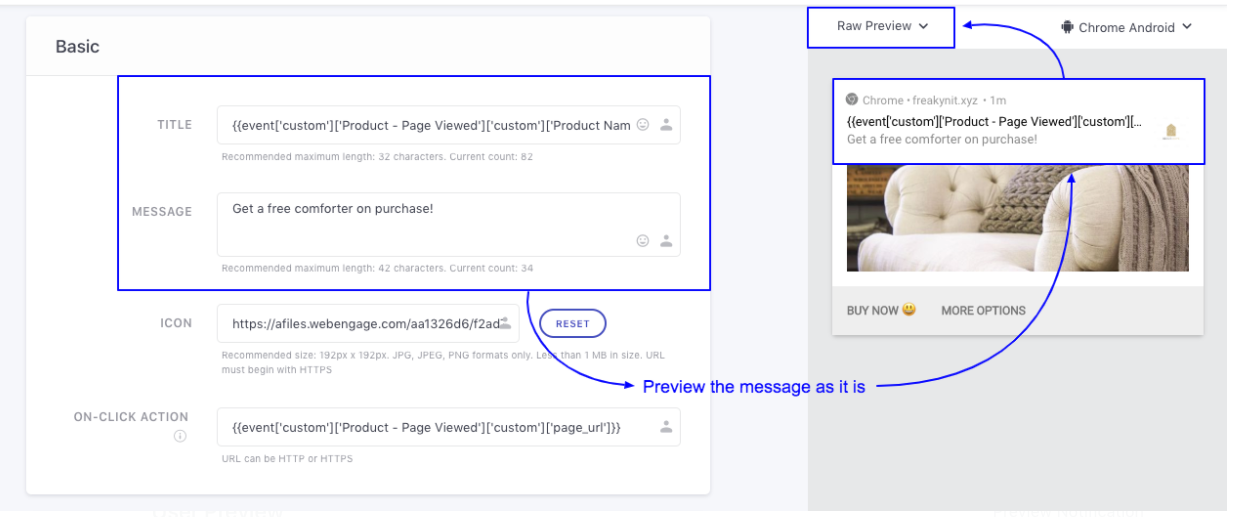
Click to enlarge
User Preview
Allows you to view the Notification for an actual user from your account by populating it with data from their user profile, as per the elements of personalization added to Title & Message.

Click to enlarge
For example, in the visual above, we have visualized the Web Push Notification for the User ID, benjamind_3674. Here's how you can go about it:
Step 1: Select User Preview from the dropdown placed on the top left
- In doing so, you will be prompted by a pop-up allowing you to search for a user to populate the corresponding attribute and event values.
Step 2: Enter the User ID, preferably of a power user included within the target audience
- Access List of Users of the campaign's target Segment (as specified at Step 1: Audience) to identify an ideal user
Step 3: Click the Search and Populate button
- In doing so, you will be shown a summary of the values against the respective attributes and events included in the message. This is a good way to ensure that all the values are available for the user, if not then you can enter an alternate User ID.
Step 4: Click the See Preview button on the pop-up to visualize the notification with real user data
- While this is a great way to gauge the overall look and feel of the Push Notification, we recommend that you test the campaign with an internal test segment to ensure that it's good to go!
Create Variations
Variations are just different versions of the campaign's message that facilitate easy multivariate testing and are referred to in the following manner in your dashboard:
Variation A: The first version of the message.
Variation B: The second version of the message.
Variation C, D, E: Subsequent versions of the message created for testing.

Click to enlarge
As shown above, by default the message creation interface consists of a single Variation A.
-
You can click on the Plus icon to create up to 5 versions of the message.
- SelectCreate New to start building the new Variation from scratch
- SelectCopy from Variation A (or any of the previous versions) to make minor edits to the new Variation
-
Each Variation can be created independent of the other, allowing you to test multiple aspects like its layout, body copy, buttons, and links to identify a mix that resonates with your entire target audience. (How to test message Variations)
-
The percentage values indicate the share of users, that will receive a Variation and can be customized at Step 4: Conversion Tracking.
Test Message
You can easily test the message with an internal segment of users before sending it to your entire user base. As shown below, click the Test Message button to select a Variation and Test Segment. Please refer to this Step-by-step Guide to proceed.

Click to enlarge
Step 4: Set up Conversion Tracking & Variation Testing
The fourth step of campaign creation allows you to measure the effectiveness of your campaign in various ways like:
- Tracking conversions for a specific goal
- Comparing performance against acontrol group
- Testing multiple variations of the message to identify a winning version
Hence, it has been divided into two sections: Conversion Tracking and Variation Distribution. However, depending on the number of message Variations created by you, the view of Step 4: Conversion Tracking varies:
When only 1 Variation Exists
As shown below, on proceeding from Step 3: Message, you will be welcomed by an interface where Conversion Tracking is disabled.
- Click the toggle switch to configure Conversion Tracking.
OR - Proceed to Step 5: Test Campaign if you don't expect users perform an action after receiving the message.

Click to enlarge
When Multiple Variations Exist
As shown below, on proceeding from Step 3: Message, you will be welcomed by an interface on which:
- Conversion Tracking is disabled.
- Variation Distribution meter indicates the share of the audience that will receive each Variation.

Click to enlarge
Let's get you acquainted with the workings of Step 4: Conversion Tracking:
Conversion Tracking
Must ReadWe recommend that you gain a broad understanding of how Conversion Tracking works in your dashboard before proceeding. Doing so will lay a strong foundation for understanding whether or not you need to enable Conversion Tracking for the campaign and its impact on Revenue Tracking.
By default, Conversion Tracking is disabled for all Push campaigns. As shown below, you can use the toggle switch to enable it.
Step 1: Select a Conversion Event
The term, Conversion Event is an alias that helps you identify the event you expect users to perform after receiving the Web Push Notification.
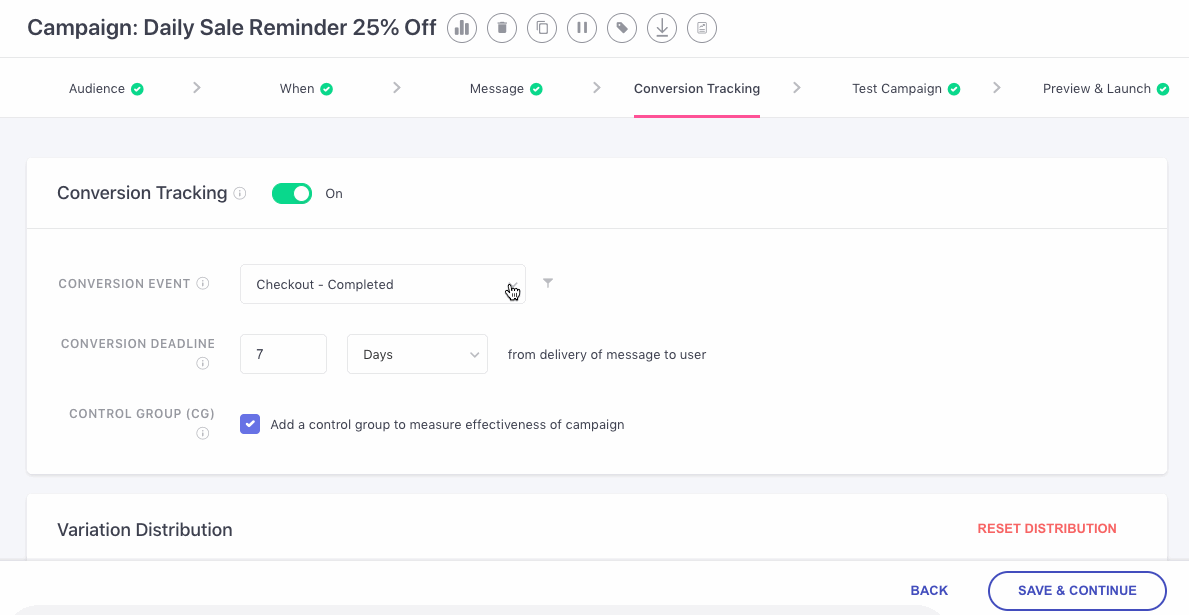
Click to enlarge
As shown above, you can choose from a list of all the Custom Events being tracked for your account to specify the campaign's conversion goal.
The following options can be selected here:
Custom (all the custom events being tracked for your account)
System (Session Started, User Login)
Pro TipWe recommend that you map all the Custom Events, that record the occurrence of a monetary transaction in your app, as Revenue Events in your dashboard. This will help ensure that selecting the respective events as the Conversion Event of a campaign helps you track Conversions and Revenue for the campaign and its channel :)
Step 2: Add Attributes to the Conversion Event
Depending on the end goal of the campaign, you can choose to narrow down the scope of conversion to a specific action like Puma Leggings Purchased, Jimmy Choo Pumps Purchased, Episode 3 Streamed, Chapter 7 Started and so on.
This can be done by adding attribute filters to the selected Conversion Event. Here's how you can go about it:
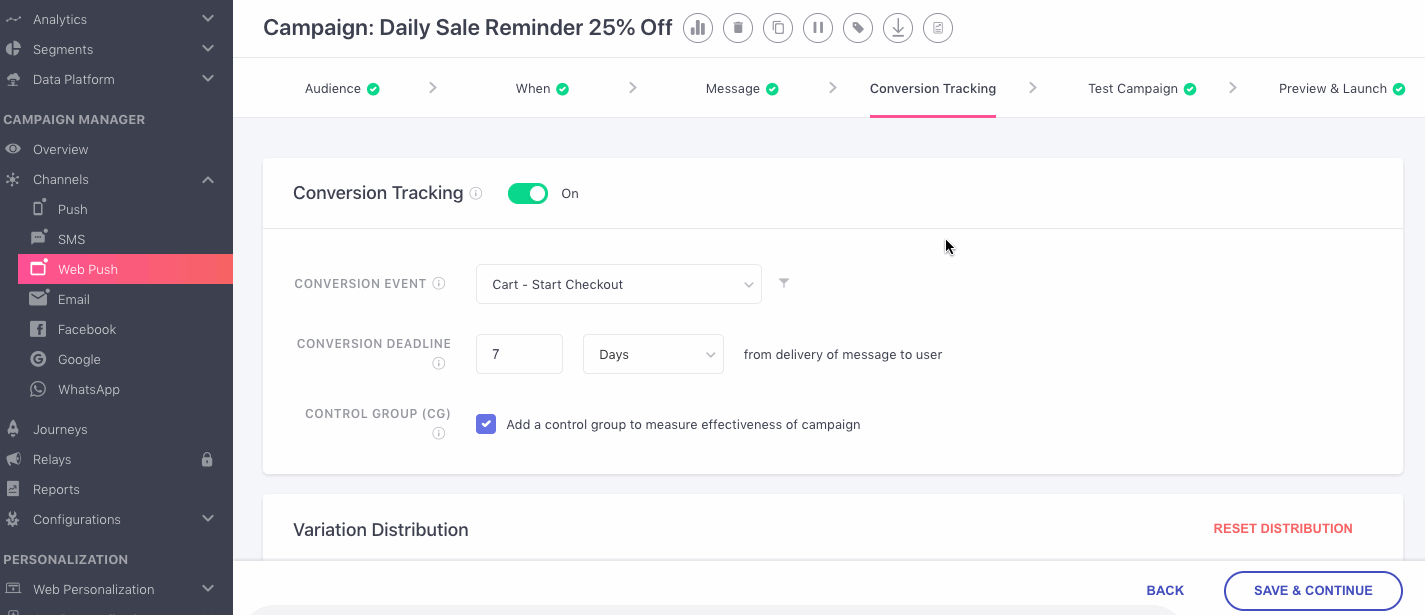
Click to enlarge
Step 1: As shown above, click on the filter icon placed next to the drop-down
- In doing so, you will be prompted by a pop-up allowing you to select an attribute and specify its value.
The following options can be selected here:
Custom (all thecustom attributes attached to the custom event selected as the conversion event)
Time (Event Time)
Location (City, Country)
Step 2: As shown below, click Add Filter to add more attributes to the event
- You can club multiple event attributes by the AND/OR logic
- This way only those users who perform the Conversion Event in the context of All/Either attribute filters will be considered towards the Conversion numbers of the campaign.
How It Works: Clubbing Event Attributes by AND/OR LogicAND: Clubbing multiple event attribute filters by the AND logic helps you narrow down the scope of occurrence of the Conversion Event. This means that only those users will be counted towards the campaign's Conversions who perform the Conversion Event in the context of all the event attributes.
OR: Clubbing multiple event attribute filters by the OR logic helps you widen the scope of occurrence of the Conversion Event. This means that users who perform the Conversion Event in the context of any of the specified event attributes* will be counted towards the campaign's conversions.
Step 3: Set Conversion Deadline
The Conversion Deadline is a duration defined by you that tells us when to stop tracking conversions for a campaign.
- This means that once your campaign is delivered, we will track users who perform the Conversion Event in the context of its attribute filters (if any), only till the specified Conversion Deadline.
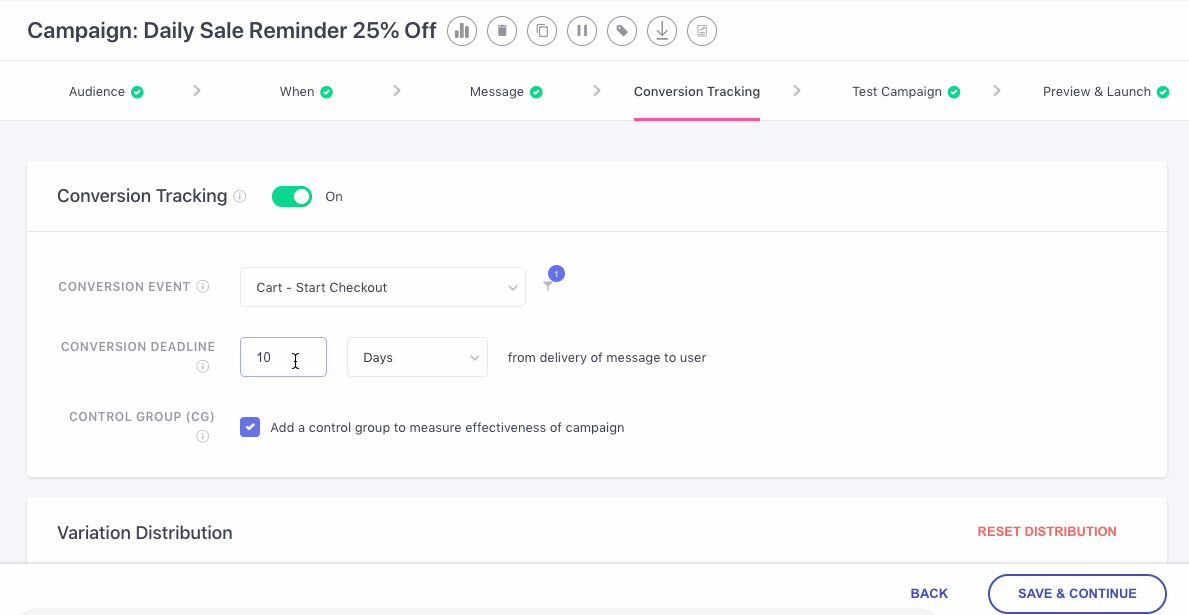
Click to enlarge
As shown above, by default, a Conversion Deadline of 7 days is set for all campaigns. You can choose to specify a custom duration in Hours or Days, as per the campaign's end goal.
Related ReadList of all the Conversion metrics and Performance Indicators tracked for Web Push campaigns
Step 4: Enable Control Group (Optional)
A Control Group is a small portion of the target audience of a campaign that is randomly selected, representing the behavior and preferences of the entire segment, and does not receive the campaign.
An optional but recommended step, adding a Control Group to the target audience allows you to compare the campaign's performance against the organic behavior of Control Group users. This makes for the perfect benchmark to assess the true impact of the campaign on influencing user behavior.
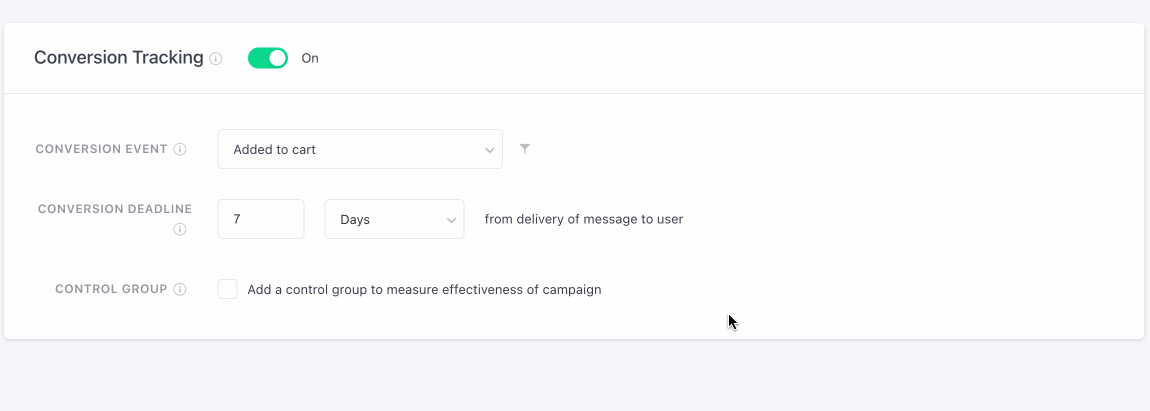
Must ReadWhy you should (almost) always use Control Group to measure the effectiveness of your campaign and how it works in your dashboard
On checking the Control Group checkbox, you are presented with another choice called 'Target Control Group', that lets you choose between two options.
- Set a new control group for this campaign
- Custom Control Group
Option 1: Set a new control group for this campaign: This will be a campaign level control group which means a control group that is created for a specific campaign only. The users in this control group are randomly added from the selected segment in 'Audience' tab. This control group is good if the aim is to measure impact for a specific campaign.
On clicking this option, the Variation Distribution slider is exposed that allows you to select percentage of users to be added in Control Group from target audience.
Option 2: Custom Control Group: This option is shown when atleast one Custom Control Groups is created in your account. Click here for detailed read on creating custom control group.
Since this is a pre-created control group, overlapping users within this group and the target segment won't be receiving the campaigns.
Custom control groups are good for analyzing effectiveness of multiple campaigns. For example: Analyzing effectiveness of SMS and Email campaigns during Diwali sale.
Unlike Campaign level control group, the percentage of users to be part of control group cannot be controlled when Custom control group is selected.
Variation Distribution (Multivariate Testing)
If you have created multiple versions of the Push Notification at Step 3: Message, then you can choose to automate the testing process by enabling Send Winning Variation Automatically. Doing so will allow you to test all the Variations(and Control Group if enabled) with a smaller test audience and we will automatically send the winning variant to the entire target audience. (detailed read)
However, you can opt to test the Variations and Control Group manually if you are unable to automate testing due to the small size of the target audience (less than 2,000 users) of a One-time or Recurring campaign. Or if you are unwilling to test a Triggered campaign by sending a minimum of 500 messages.
Send Winning Variation Automatically
Must Read
Basics of setting up Send Winning Variation Automatically for a campaign
How Send Winning Variation Automatically enables intuitive multivariate testing for your campaign
Depending on the campaign type selected at Step 2: When, the steps of setting up automated variation testing will vary.
Testing a One-time Campaign
Given the short lifespan of one-time campaigns, we suggest that you launch the campaign well in advance for testing, and schedule it for delivery at the most viable time slot (as suggested by the channel's engagement trends). Doing so will ensure that your users receive the most effective version of your campaign at a time that records the highest engagement rate.
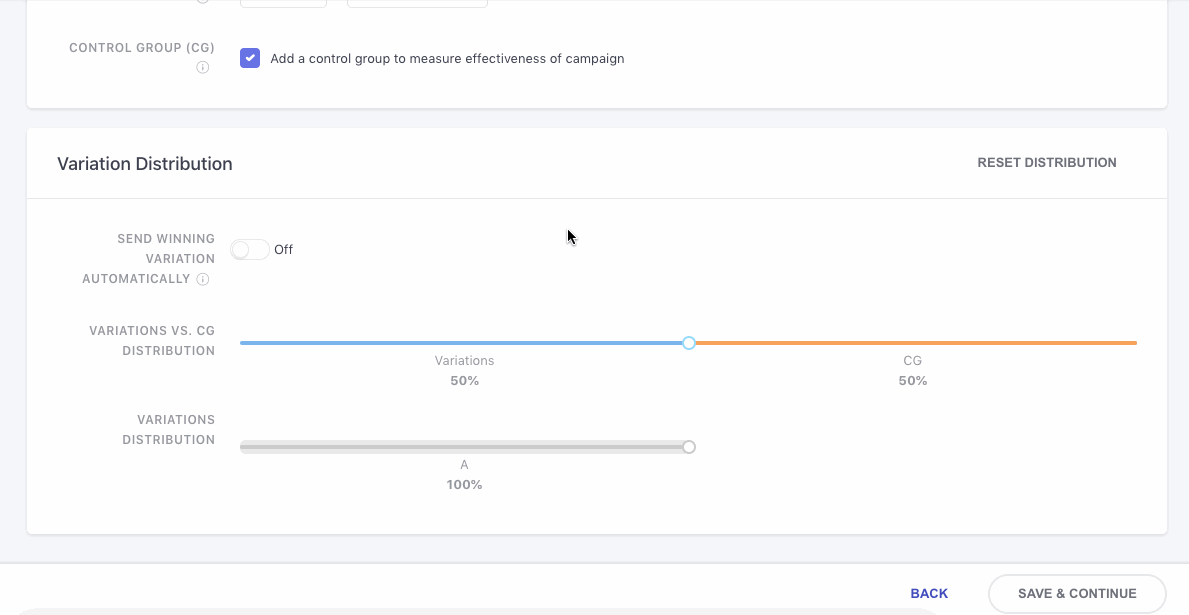
Click to enlarge
Step 1: Specify Size of Test Audience
You can choose to test the Variations and Control Group (if added) with 5% to 25% of the campaign's entire target audience. As shown above, we have chosen to treat 15% of all users as the Test Audience.
Step 2: Define Time to Test
A custom test duration can be specified in Minutes or Hours. As shown above, we have specified a test duration of 8 Hours. This means that the impact of all the message Variations and organic behavior of the Control Group (if added) will be tracked for 8 Hours, after which we will determine a winner.
Step 3: Select Win Criteria
The Win Criteria is a performance indicator that helps us determine a winning Variation according to the campaign's end goal. As shown above, it can be defined as Clicks or Conversions, as per your needs.
Quick Read: How automated variation testing works for one-time campaigns
Testing a Triggered Campaign
Triggered campaigns are on-going cycles of communication that are sent to users only when they perform a certain action or Event. Thus, the most scientific way to test Variations of a triggered campaign is by ensuring that a significant number of messages are delivered before we draw a comparison.
Step 1: Specify Size of Test Audience
The Test Audience can be defined only in terms of the number of messages delivered. This means that Variation testing will continue until the specified number of messages have been successfully delivered.
As shown below, we have specified that a minimum of 1500 messages must be triggered to users to identify a winning version. This means that all the Variations will be equally divided amongst the specified number.
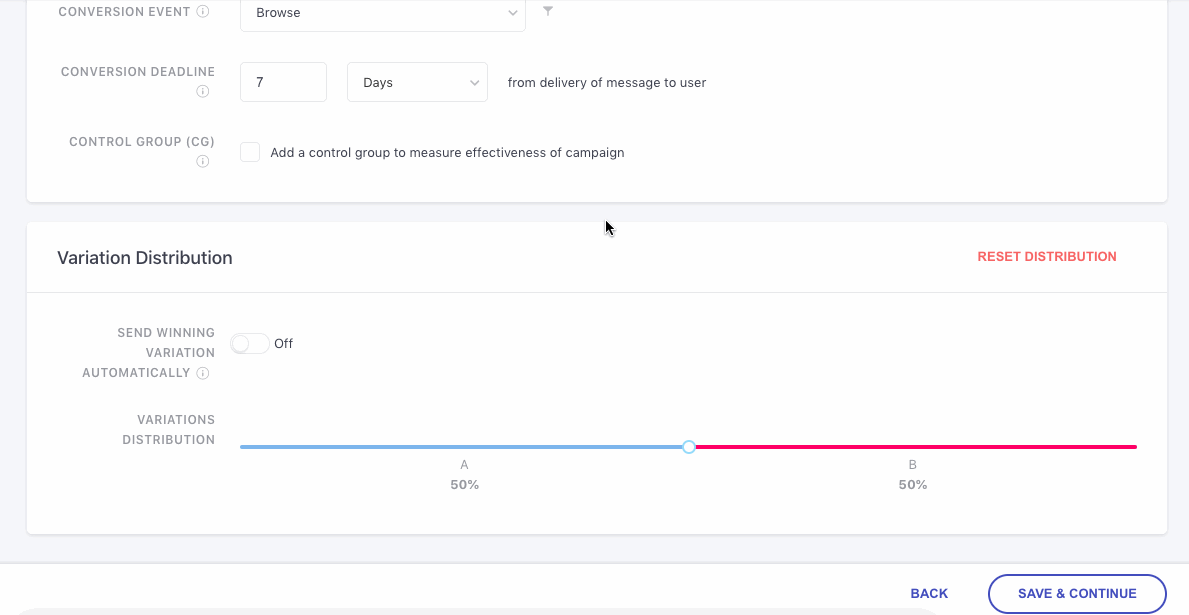
Click to enlarge
Step 2: Select Win Criteria
The Win Criteria is a performance indicator that helps us determine a winning Variation according to the campaign's end goal. As shown above, it can be defined as Clicks or Conversions, as per your needs.
- Once we identify a winning Variation, it will be sent as the only campaign to all the subsequent users who perform the trigger event.
Quick Read: How automated variation testing works for triggered campaigns
Testing a Recurring Campaign
If you choose to create a Recurring campaign at Step 2: When, then the entire first run of the campaign will be considered as its Test Audience by default.
- We will calculate the test results 1 hour before the second run of the campaign to identify a winning variation.
- A winning Variation will be determined as per the Win Criteria and will be sent as the only campaign to all users from the second run. onwards.
Thus, as shown below, just need to define the Win Criteria as Clicks or Conversions and we will take care of the rest.
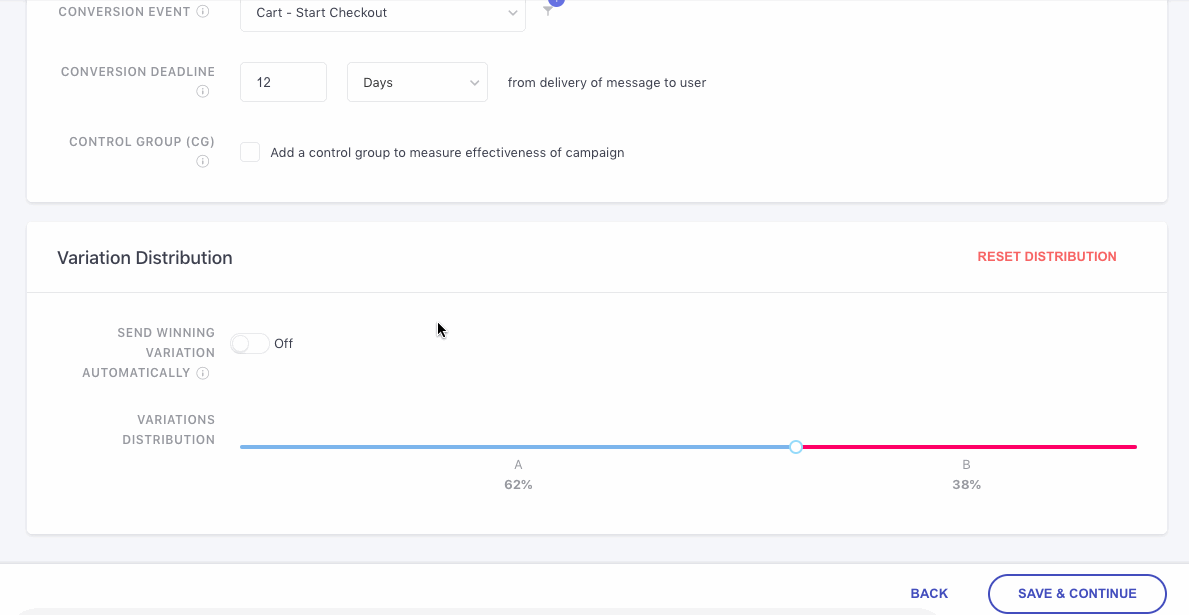
Click to enlarge
Quick Read: How automated variation testing works for recurring campaigns
Manual Distribution
If you are unable to set up Send Winning Variation Automatically due to the small size of the target audience (less than 2,000 users) of a One-time or Recurring campaign, or if you are unwilling to test a Triggered campaign with a minimum of 500 messages, then you can choose to test the Variations manually.
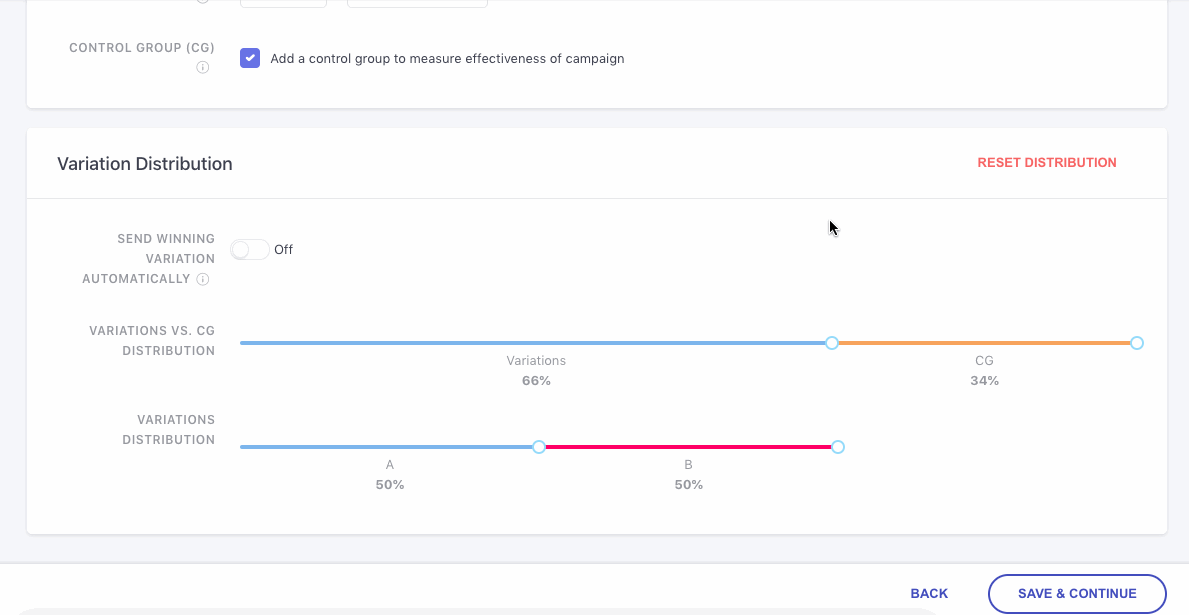
Click to enlarge
Quick Read: How manual Variation Distribution works
Depending on your Variation testing settings, the campaign will be tested against the Control Group in either of the following ways:
Impact on Variation Slider if Control group is enabled
In case the Control Groups have been enabled the Variation Distribution slider behaves differently based on the type of control group selected:
If Campaign level control group is selected: In this case, the user will have the option of adding the control group by deciding the percentage or size of the control group on variation distribution slider.
If Custom Control Group is selected: You will not be able to manually select the size of the control group using the variation slider since the Custom Control Group is pre-created and overlapping users in the selected Custom Control Group and target segment, won't be receiving the campaign.
Keep in mind
In a particular campaign, Custom Control Group and campaign control group cannot be applied together.
Universal control group can be added irrespective of Custom Control Group or Campaign Control Group is selected.
In case multiple control groups are applied within same campaign (E.g: Universal Control Group + Custom Control Group or Universal Control Group + Campaign control): In this case, since the users in both the control group are mutually exclusive, the overall control group size will increase and the target audience size will decrease.
Step 5: Test Your Campaign (Recommended)
Iron out all the creases in your Push Notification by testing it with internal team members for maximum impact!
While this is an optional step, we recommend that you test all campaigns that contain images, buttons, deep links, and elements of personalization in the message to ensure that everything's in order. This can be easily done by creating a Test Segment and adding all the stakeholders to it.
However, you can always choose to skip it by clicking the Skip Test & Proceed button, as highlighted above. Doing so will take you to the final step of campaign creation - Step 6: Preview & Launch.
Now, let's show you how you can test all the message Variations:
Step 5.1.: Select a Variation

Click to enlarge
As shown above, by default, Variation A is selected against the field - Variation To Test.
However, if you have created multiple Variations then you can test each one by sending them consecutively to a Test Segment.
Step 5.2.: Select Test Segment

Click to enlarge
As shown above, all the test segments created while testing a campaign, for any channel (Push, SMS, Web Push, Email, WhatsApp), can be found under the dropdown, Send Test Message To, along with details of all its users.
Haven't created a test segment yet?
Step 5.3.: Personalize Test Message

Click to enlarge
As highlighted above, you can test personalization in two ways:
- Use own data of users included in the test segment to receive a message personalized to your user profile
- Use data of a specific user to receive the exact message that the selected user would receive
- On selecting this option, you will be prompted to search for a user in your database.
- We recommend selecting this option if you have personalized the message to a very specific set of custom events or user attributes that are unlikely to be available for an internal team member.
Here's how you can personalize the message to a specific user:
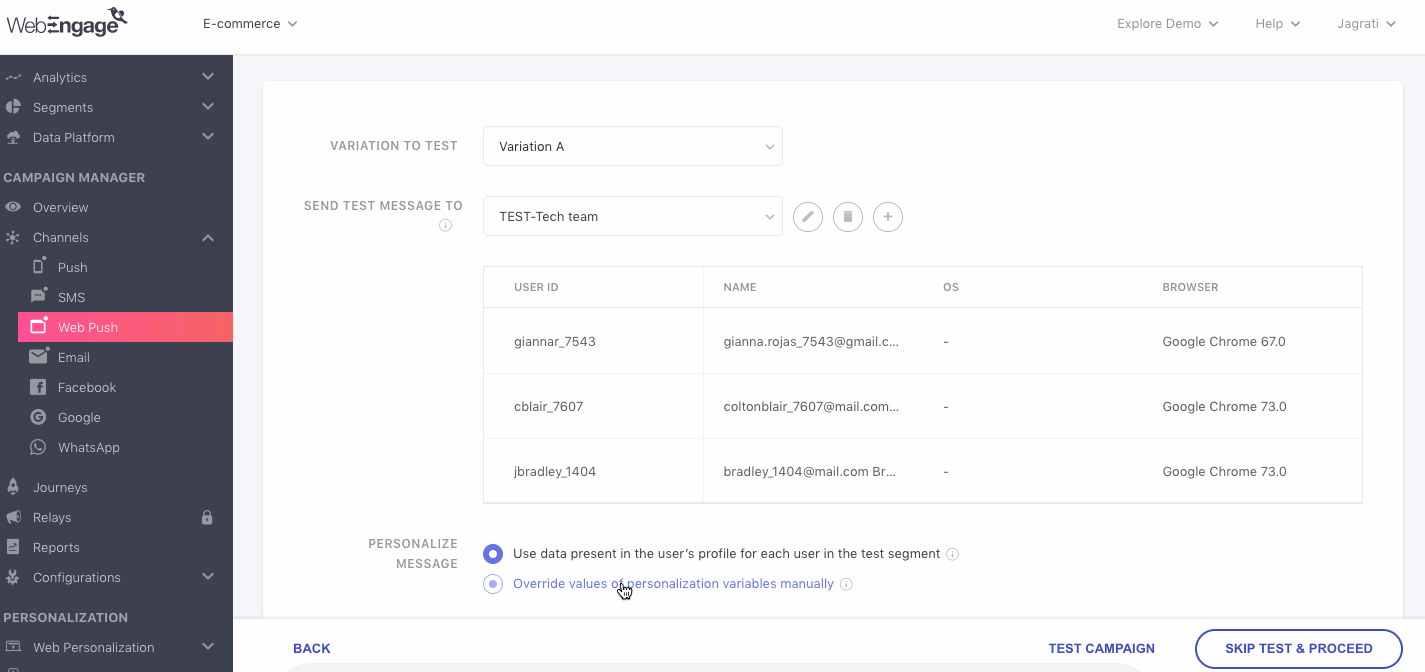
Click to enlarge
Step 1: Click the Search User button
- In doing so, you will be prompted by a pop-up allowing you to search your user base
Step 2: Add the User ID, preferably of a power user included within the target audience
- Access List of Users of the campaign's target Segment (as specified at Step 1: Audience) to identify an ideal user
Step 3: Click the Search and Populate Values button
- In doing so, you will be shown a summary of the values against the respective attributes and events included in the message. This is a good way to ensure that all the values are available for the user. If not, then you can enter an alternate User ID to personalize the message.
- Next, click the Save and Return to Test Campaign button to proceed with the selected user
Step 4: Click the Send Test & Proceed button to test the campaign!
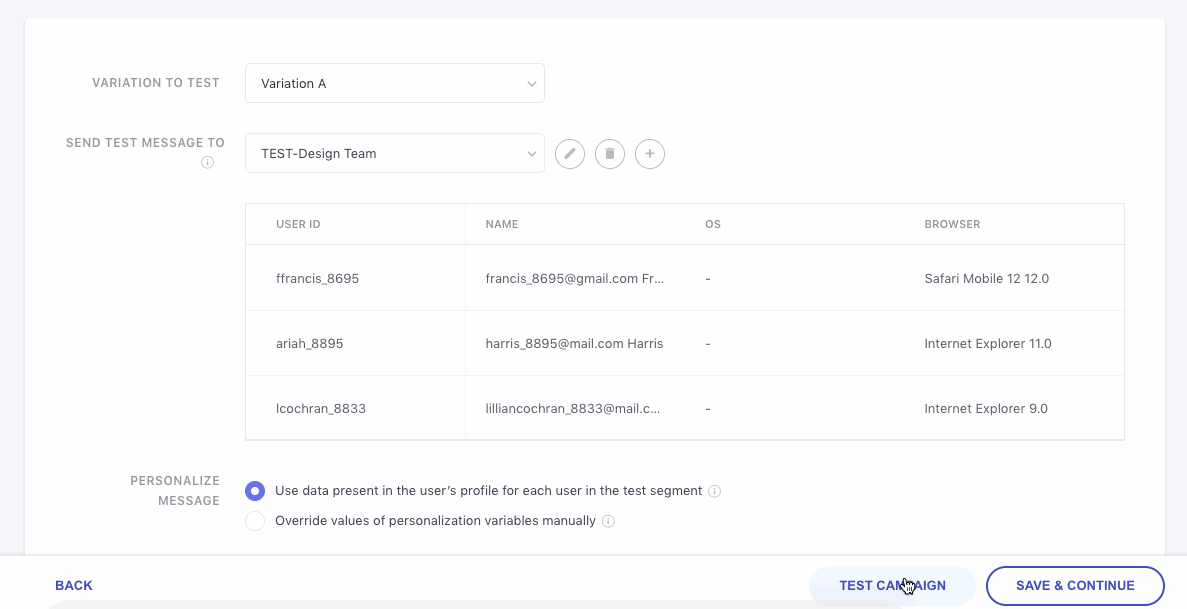
Click to enlarge
Please NoteAfter the Test Message has been sent, you will see that it is in Queue. After some time you will be able to see the delivery status of the test message as Delivered or Failed.
The Delivery details include Device details, Browser Name, and so on.
If the Test Message has Failed to deliver, then you will be able to see the reason for failure.
Creating Test Segment
Prerequisite for adding internal team members to a test segmentAs you are aware, all the data stored in your WebEngage is either gleaned from your integrated apps and website or can be manually uploaded as a CSV file. Thus, it may so happen that details of internal teammates may not be readily available in your dashboard (even if they are account admins).
Hence, we recommend that you request the respective members to sign up on your platform so that we can populate their respective User Profiles with their personal and behavioral data. Doing so will come in handy when:
Creating Test Segments
Personalizing the test message to the data of users added to the test segment
Viewing a User Preview of the message at Step 3: Message
Step 1: Name Your Test Segment
As shown below, the segment's name is prefixed with 'TEST -' and can be customized henceforth. For example, we have named our segment, TEST - Prod team.
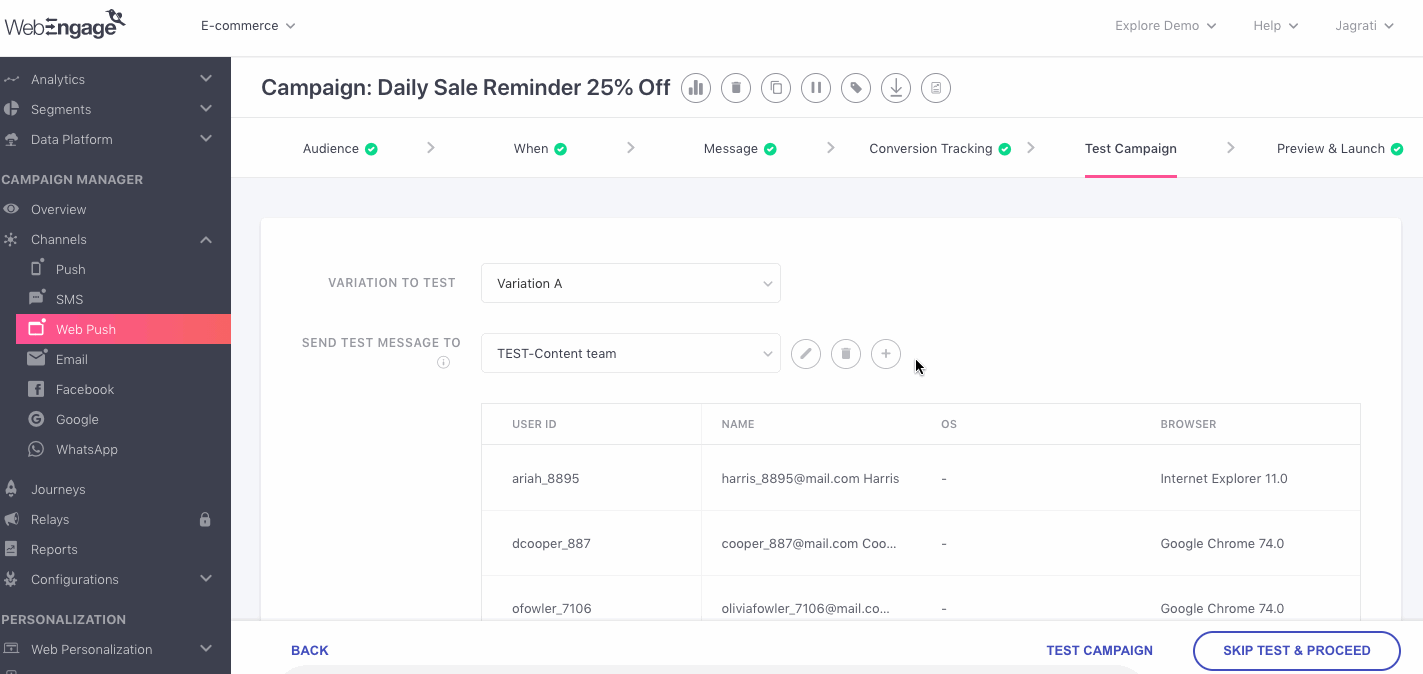
Click to enlarge
Step 2: Add Internal Users Through Filters
As shown above, you can segment internal members by manually adding their User ID, Email Address or Phone Number(the chosen filter will depend on the Unique Identifier or the parameter that helps identify users in your WebEngage account, as specified by you).
Step 3: Click on the Create Test Segment button.
Pro TipWe recommend that you leverage the diverse device preferences of your teammates to test the Web Push Notification on multiple devices (desktop, mobile, tablet), browsers (Firefox, Chrome, Safari) and OS (Mac, Windows, Android, iOS) to ensure that it looks stunning all across!
Editing Test Segment
Step 1: As shown below, click the Edit icon placed next to the field - Send Test Message To to edit the users included within the selected Test Segment.
- In doing so, you will be prompted by a pop-up, pre-populated with details of existing users.
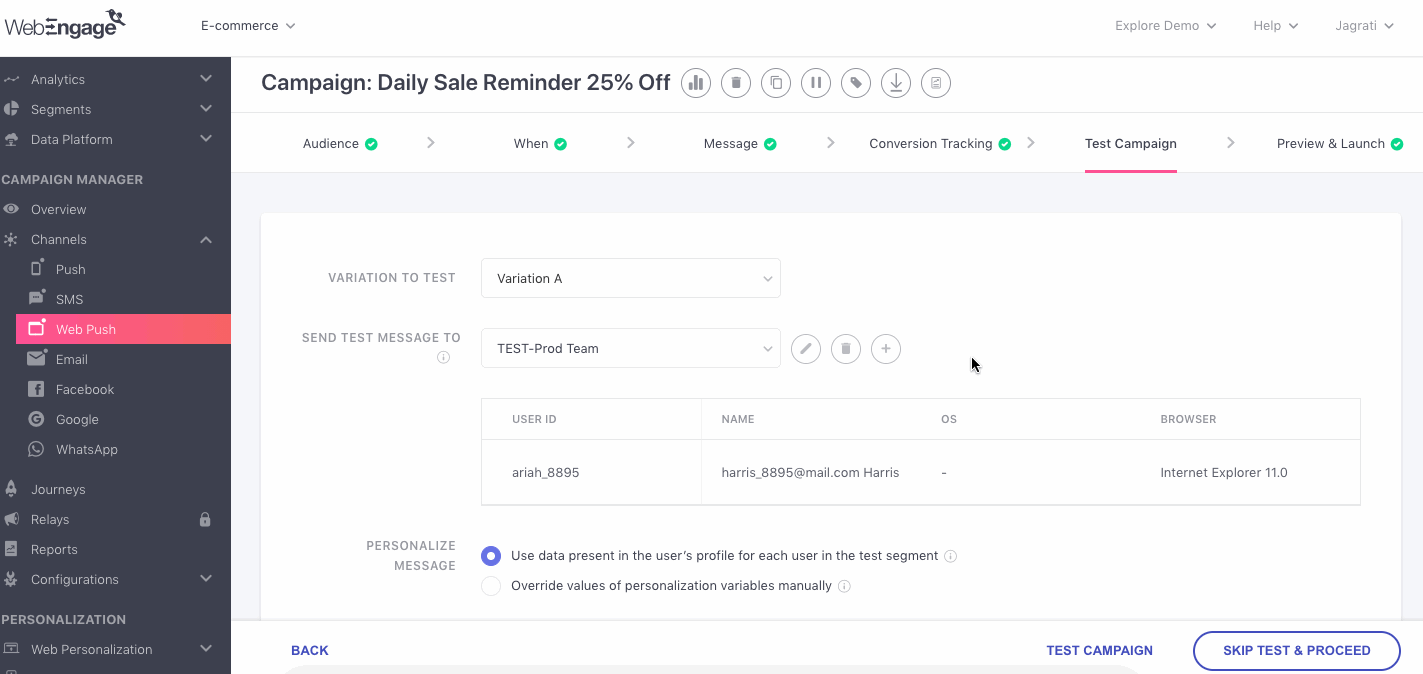
Click to enlarge
Step 2: As shown above, make all your changes and click the Update Test Segment button to proceed. For example, we have added new members to the segment, TEST - Prod team.
Deleting Test Segment
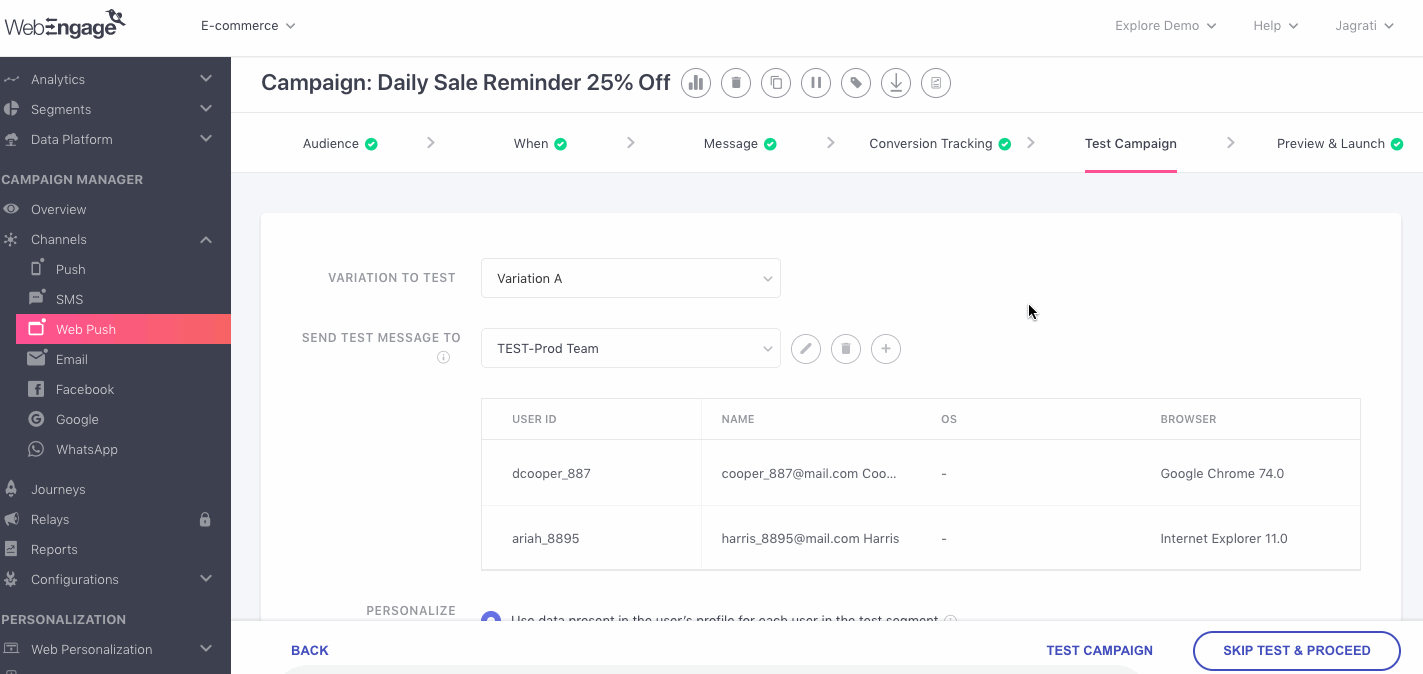
Click to enlarge
Step 1: As shown above, click the Bin icon placed next to the field - Send Test Message To to delete the selected Test Segment.
- In doing so, you will be prompted to confirm your decision.
Step 2: Click the Delete Segment button on the pop-up.
- In doing so, a notification will pop-up on the bottom right confirming the deletion.
Are your Web Push notifications are being marked as “Potential Spam"?If your notifications are being marked as spam, this behavior stems from updates implemented by Google Chrome.
Based on our checks, notifications are rendering correctly on WebEngage, and your campaign setup is in order. However, the disclaimer you’re seeing is triggered by Chrome’s built-in detection systems, which WebEngage cannot modify or override.
Google has introduced platform-level enhancements that use AI to identify and flag notifications it considers potentially suspicious, even when the content or sender is legitimate. This initiative is designed to improve user safety and reduce scams.
Click here to know more.
Step 6: Preview & Launch
Once you are satisfied with the test results, it's time to send the Web Push Notification to your users! But before that, we recommend that you conduct a quick preview of the campaign's message and settings to ensure that it's in line with your end goal.

Click to enlarge
As shown above, the last step of campaign creation presents a snapshot of its:
- Target Segment (Step 1: Audience)
- Campaign Type, Delivery Time, Frequency Capping, DND Hours and Queueing settings (Step 2: When)
- Message Variations (Step 3: Message)
- Conversion Tracking and multivariate test settings (Step 4: Conversion Tracking)
Edit Campaign Before Launch
You can always choose to edit a step by clicking the Edit icon, placed next to each step's header. In doing so, you will be directed back to the step, as shown below.

Click to enlarge
Simply make your edits, save them, toggle back to Step 6: Preview & Launch to continue your review, as shown above.
Saving Campaign as a Draft
If you're unsure or are awaiting approval of the campaign's contents, then you can simply go back to the central hub of Web Push after saving your settings, as shown below. Doing so will automatically save the campaign as a Draft, allowing you to edit or launch it anytime you like.
Launching Scheduled Campaigns
If you have chosen to schedule/ start the campaign at a later date-time, then on launching it, its status will indicate Upcoming in Web Push, List of Campaigns, as shown below.

Click to enlarge
What Happens After a Campaign is Launched?
Once launched, messages are sent to users included in the target audience as per the campaign's settings. Throughout it's run time, the campaign's status will indicate Running (in Web Push, List of Campaigns) until it ends or is manually paused by you.
1. Analyzing Campaign's Performance
You can analyze each campaign's real-time impact on user engagement, conversions, and revenue by accessing its Overview section through the List of Campaigns of Web Push.
2. Modifying the Campaign
Further, you can always choose to Edit and Pause an Upcoming or Running) campaign if you feel the need to. (Step-by-step guide on modifying Web Push campaigns)
3. Scheduling Campaign Reports
Once you have launched a campaign, you easily monitor its performance through scheduled reports, delivered straight to your (& your teammate's) inbox! This can be configured through the campaign's analysis section. Here's how you can go about it.
Further, you can also schedule Channel-wise reports to monitor the overall performance of Web Push through the Settings section of your account. Here's how you can go about it.
We hope this has equipped you with a robust understanding of how you can create various types of campaigns, track conversion, automate multivariate testing, and test your campaign internally before launch. Please feel free to drop in a few lines at [email protected] in case you have any queries or feedback. We're always just an email away!
Updated about 2 months ago
Let's show you how you can analyze Web Push campaigns to measure their impact on user engagement, conversions, and revenue.